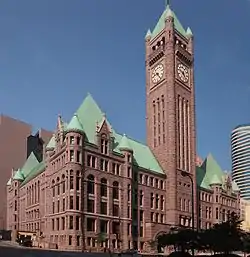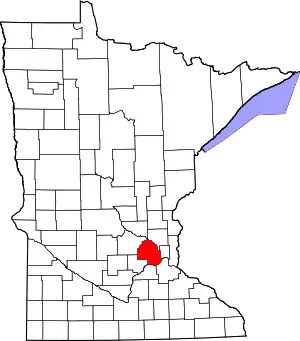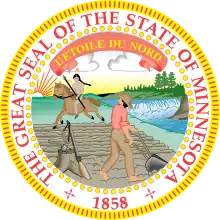Minneapolis
Minneapolis (/ˌmɪniˈæpəlɪs/ (![]() listen)) is the most populous city in the US state of Minnesota and the seat of Hennepin County.[6] With an estimated population of 429,606 as of 2019, it is the 46th most populous city in the US.[7] Seven counties encompassing Minneapolis and its neighbor Saint Paul are known as the Twin Cities.[8] In 2019, those counties are among sixteen making up the Minneapolis–St. Paul–Bloomington MN–WI metropolitan area of 3.6 million, and twenty-two making up the combined statistical area of 4.0 million.[9]
listen)) is the most populous city in the US state of Minnesota and the seat of Hennepin County.[6] With an estimated population of 429,606 as of 2019, it is the 46th most populous city in the US.[7] Seven counties encompassing Minneapolis and its neighbor Saint Paul are known as the Twin Cities.[8] In 2019, those counties are among sixteen making up the Minneapolis–St. Paul–Bloomington MN–WI metropolitan area of 3.6 million, and twenty-two making up the combined statistical area of 4.0 million.[9]
Minneapolis, Minnesota | |
|---|---|
| City of Minneapolis | |
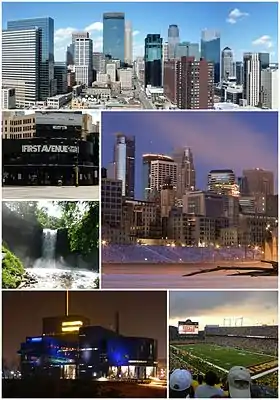 Clockwise from top: Downtown Minneapolis, Downtown East from the Stone Arch Bridge, TCF Bank Stadium, the Guthrie Theater, Minnehaha Falls, and First Avenue nightclub. | |
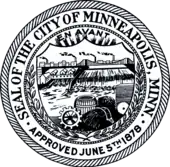 Seal | |
| Etymology: Dakota word mni ('water') with Greek polis ('city') | |
| Nickname(s): "City of Lakes", "Mill City", "Twin Cities" (a nickname shared with Saint Paul), "Mini Apple" | |
| Motto(s): En Avant (French: 'Forward') | |
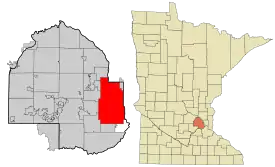 Location within Hennepin County | |
 Minneapolis Location within Minnesota  Minneapolis Location within the United States 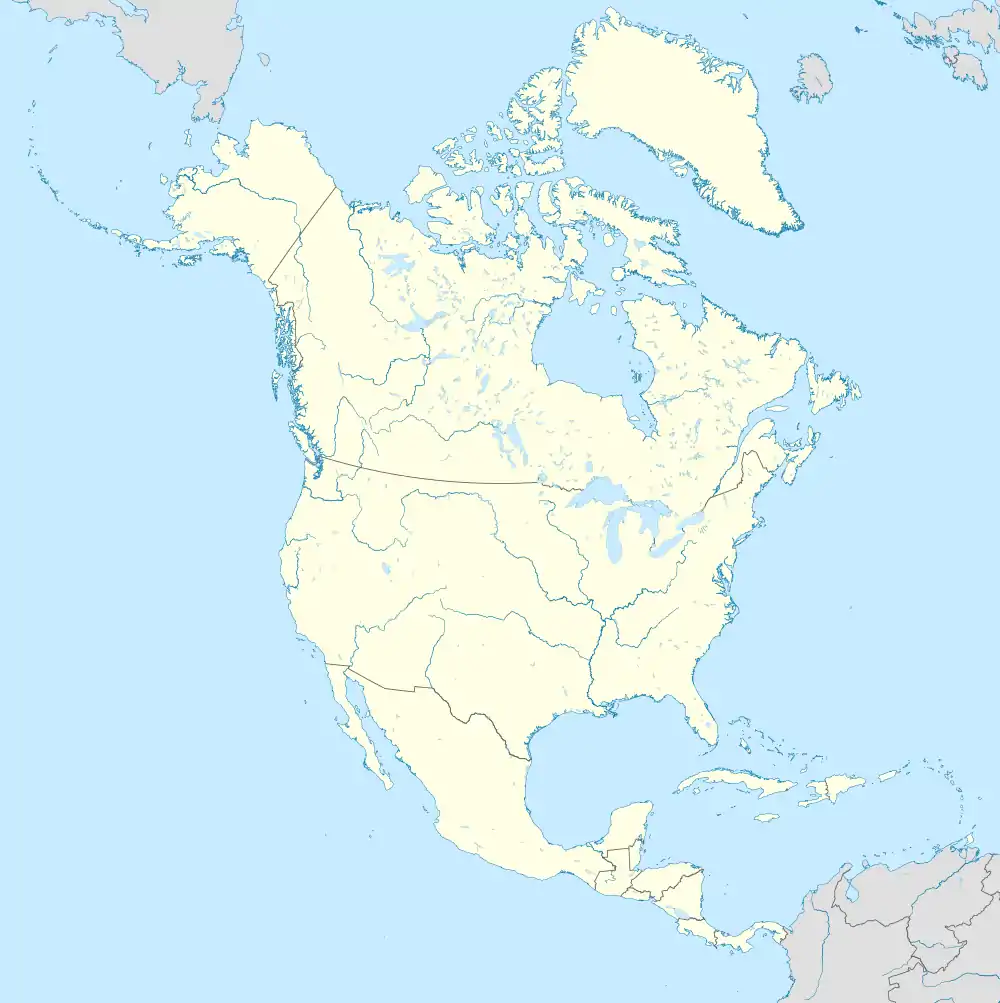 Minneapolis Minneapolis (North America) | |
| Coordinates: 44°58′55″N 93°16′09″W | |
| Country | |
| State | |
| County | Hennepin |
| Incorporated | 1867 |
| Founded by | John H. Stevens and Franklin Steele |
| Government | |
| • Type | Weak mayor–council[1] |
| • Body | Minneapolis City Council |
| • Mayor | Jacob Frey (DFL) |
| • Council President | Lisa Bender (DFL) |
| Area | |
| • City | 57.49 sq mi (148.89 km2) |
| • Land | 54.00 sq mi (139.86 km2) |
| • Water | 3.49 sq mi (9.03 km2) |
| Elevation | 830 ft (264 m) |
| Population | |
| • City | 382,578 |
| • Estimate (2019)[4] | 429,606 |
| • Rank | US: 46th MN: 1st |
| • Density | 7,955.67/sq mi (3,071.72/km2) |
| • Metro | 3,629,190 (US: 16th)[5] |
| • CSA | 4,014,593 (US: 16th) |
| Demonym(s) | Minneapolitan |
| Time zone | UTC–6 (CST) |
| • Summer (DST) | UTC–5 (CDT) |
| ZIP Codes | 55401–55488 (range includes some ZIP Codes for Minneapolis suburbs) |
| Area code(s) | 612 |
| FIPS code | 27-43000 |
| Major airport | Minneapolis–Saint Paul International Airport |
| Interstates | |
| US Routes | |
| Public transportation | Metro Transit |
| Website | www |
Minneapolis lies on both banks of the Mississippi River, just north of the river's confluence with the Minnesota River, and adjoins Saint Paul, the state's capital. With one of the nation's best park systems,[10] the city is abundantly rich in water, with thirteen lakes, wetlands, the Mississippi River, creeks and waterfalls, many connected by parkways in the Grand Rounds National Scenic Byway. The city and surrounding region is the largest population and primary business center between Chicago and Seattle. Minneapolis was historically a marketplace for timber, became the flour milling capital of the world,[11] and, to the present day, preserved its financial clout.
Anchoring strong music and performing arts scenes, Minneapolis is home to both the Guthrie Theater and the First Avenue nightclub. Reflecting the region's status as a center of folk, funk, and alternative rock music, the city was the launching pad for several of the 20th century's most influential musicians, including Bob Dylan and Prince. Hip-hop and rap scenes produced artists Lizzo, Brother Ali, Atmosphere, and Dessa.
History
Dakota natives, city founded
The Dakota Sioux were the region's sole residents prior to European contact. The city's Dakota name is Bdeóta Othúŋwe ('Many Lakes City').[12] French explorers arrived in the region in 1680. Gradually, more European-American settlers arrived, competing for game and other resources with the Native Americans. By the Treaty of Paris following the Revolutionary War, British land east of the Mississippi River became part of the United States.[13][14] In the early 19th century, the US acquired land to the west of the river from France in the Louisiana Purchase. Fort Snelling was built in 1819 by the US Army at the southern edge of present-day Minneapolis,[15] to direct Indian trade away from the British-Canadian traders, and to prevent the Dakota and Ojibwe in the north from fighting each other.[16] The fort attracted traders, settlers and merchants, spurring growth. Agents of the St. Peters Indian Agency built at the fort enforced US policy of assimilating Native Americans into European-American society, asking them to give up hunting for subsistence and to learn to plow for cultivation.[17] The US government pressed the Dakota to sell their land which was ceded in a succession of treaties. The US reneged on the treaties during the Civil War, resulting in hunger, war, internment, and exile of the Dakota from Minnesota.[18]
Outwitting the fort's commandant, Franklin Steele laid his claim on the east bank of Saint Anthony Falls,[16] and John H. Stevens built his home on the west bank.[19] Residents had divergent ideas on names for their community. In 1852, the city's first schoolmaster, Charles Hoag, proposed Minnehapolis, with a silent h, combining the Dakota word for "waterfall", Mníȟaȟa,[12] and the Greek word for "city", polis, which became Minneapolis, meaning 'city of the falls'. The Minnesota Territorial Legislature authorized Minneapolis as a town in 1856, on the Mississippi's west bank.[20] Minneapolis incorporated as a city in 1867 and later joined with the east-bank city of St. Anthony in 1872.[21]
Waterpower; lumber and flour milling
Minneapolis developed around the power source of Saint Anthony Falls, the highest waterfall on the Mississippi River. Forests in northern Minnesota encouraged a lumber industry, which operated seventeen sawmills on power from the waterfall. By 1871, the west river bank had twenty-three businesses, including flour mills, woolen mills, iron works, a railroad machine shop, and mills for cotton, paper, sashes, and planing wood.[22] Due to the occupational hazards of milling, six competitors manufactured artificial limbs by the 1890s.[23] The farmers of the Great Plains grew grain that was shipped by rail to the city's thirty-four flour mills. Millers have used hydropower since the 1st century B.C.,[24] but the results in Minneapolis between 1880 and 1930 were described as "the greatest direct-drive waterpower center the world has ever seen."[25] For this half century, Minneapolis led the world in flour milling.[25]
A father of modern milling in America and founder of what became General Mills, Cadwallader C. Washburn revolutionized his business from gristmills to "gradual reduction" by steel and porcelain roller mills capable of producing premium-quality pure white flour very quickly.[26][27] Some ideas were developed by William Dixon Gray[28] and some say they were acquired through industrial espionage from Hungary by William de la Barre.[27] Charles A. Pillsbury and the C.A. Pillsbury Company across the river were barely a step behind, hiring Washburn employees to immediately use the new methods.[27] The hard red spring wheat that grows in Minnesota became valuable ($0.50 profit per barrel in 1871 increased to $4.50 in 1874),[26] and Minnesota "patent" flour was recognized at the time as the best in the world.[27] Not until later did consumers discover the value in the bran that "...Minneapolis flour millers routinely dumped" into the Mississippi.[29]
A single mill at Washburn-Crosby could make flour for twelve million loaves of bread each day,[30] and by 1900, 14 percent of America's grain was milled in Minneapolis.[26][27] Further, by 1895, through the efforts of silent partner William Hood Dunwoody, Washburn-Crosby exported four million barrels of flour a year to the United Kingdom.[31] When exports reached their peak in 1900, about one third of all flour milled in Minneapolis was shipped overseas.[31]
Social tensions
The city made changes to rectify discrimination as early as 1886 when Martha Ripley founded Maternity Hospital for both married and unmarried mothers.[32] Known initially as a kindly physician, mayor Doc Ames made his brother police chief, ran the city into corruption, and tried to leave town in 1902.[33] Lincoln Steffens published Ames' story in "The Shame of Minneapolis" in 1903.[34] The gangster Kid Cann engaged in bribery and intimidation from the 1920s until the 1940s.[35]
Bigotry played multiple roles during the early 20th century. In 1910, a Minneapolis developer wrote restrictive covenants based on race and ethnicity into his deeds. Copied by other developers, the practice prevented Asian and African Americans from owning or leasing certain properties. Though such language was prohibited by state law in 1953 and by the federal Fair Housing Act of 1968, restrictive covenants against minorities remained in many Minneapolis deeds as recently as 2017.[36] The Ku Klux Klan succeeded by entering family life, but effectively was a force in the city only from 1921 until 1923.[37] After Minnesota passed a eugenics law in 1925, the proprietors of Eitel Hospital sterilized about one thousand people at the Faribault State Hospital.[38]
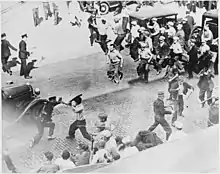
From the end of World War I until 1950, Minneapolis was a site of corrosive anti-semitism. A hate group called the Silver Legion of America held meetings in the city around 1936 to 1938.[39] Answering bigotry against Jewish doctors, Mount Sinai Hospital opened in 1948 as the community's first hospital to accept members of minority races and religions on its staff.[40][39]
When the country's fortunes turned during the Great Depression, the violent Teamsters Strike of 1934 resulted in laws acknowledging workers' rights.[41] A lifelong civil rights activist and union supporter, mayor Hubert Humphrey helped the city establish fair employment practices and a human relations council that interceded on behalf of minorities by 1946.[42] In the 1950s, less than 2 percent of the population was nonwhite.[43]In 1966–1967, years of significant turmoil across the US, bottled-up anger in the black population was released in two disturbances on Plymouth Avenue.[44][45] A coalition was able to reach a peaceful aftermath but ultimately failed to solve black poverty and unemployment, and a law and order candidate became mayor.[46] Minneapolis contended with white supremacy, participated in desegregation and the civil rights movement, and in 1968 was the birthplace of the American Indian Movement.[47]
Between 1958 and 1963, as part of the most monumental urban renewal plan ever tackled in America,[48] the city razed roughly 40 percent of downtown, destroying the Gateway District and its significant architecture, including the Metropolitan Building. Efforts to save the building failed but sparked interest in historic preservation.[49]
On May 25, 2020, Minneapolis police officer Derek Chauvin was seen on video kneeling on George Floyd's neck for eight minutes, resulting in his death. This incident sparked national unrest, riots, and mass protests.[50] The Twin Cities experienced prolonged unrest in 2020 as part of an ongoing culture war focusing on racial issues.[51]
Geography

The history and economic growth of Minneapolis are tied to water, the city's defining physical characteristic. Long periods of glaciation and interglacial melt carved several riverbeds through what is now Minneapolis.[53] During the last glacial period around ten thousand years ago, ice buried in these ancient river channels melted, resulting in basins that would fill with water to become the lakes of Minneapolis.[53] The glacial River Warren, fed by the meltwater of Lake Agassiz, created a large waterfall in what is now downtown Saint Paul that eroded upriver past the confluence of the Mississippi River, where it left a 75-foot (23 m) drop in the Mississippi.[54] The new waterfall, later called Saint Anthony Falls, in turn eroded up the Mississippi about eight miles (13 km) to its present location; Minnehaha Falls also developed during this period.[54][53]
Lying on an artesian aquifer[55] and flat terrain, Minneapolis has a total area of 59 square miles (152.8 km2) and of this 6 percent is water.[56] Water supply is managed by four watershed districts that correspond to the Mississippi and the city's three creeks.[57] Thirteen lakes, three large ponds, and five unnamed wetlands are within Minneapolis.[57]

A 1959 report by the U.S. Soil Conservation Service listed Minneapolis's elevation as 830 feet (250 m).[58] The city's lowest elevation of 687 feet (209 m) above sea level is near where Minnehaha Creek meets the Mississippi River.[59][60] Sources disagree on the exact location and elevation of the city's highest point, which is cited as being anywhere from 965–985 feet (294–300 m) above sea level.[lower-alpha 1]
Neighborhoods
Minneapolis is divided into eleven communities, each containing several neighborhoods, of which there are eighty-three. In some cases two or more neighborhoods act together under one organization. Some areas are known by nicknames of business associations.[63]
In 2018, the Minneapolis City Council voted to end single-family zoning citywide. At the time, 70 percent of residential land was zoned for detached single-family homes, however many of those areas had "nonconforming" buildings with more housing units. City leaders sought to increase the supply of housing so that more neighborhoods would be affordable, and decrease the effects that single family zoning had caused on racial disparites and segregation.[64] The Brookings Institution called it "a relatively rare example of success for the YIMBY agenda."[65]
Cityscape
Climate
| Minneapolis | ||||||||||||||||||||||||||||||||||||||||||||||||||||||||||||
|---|---|---|---|---|---|---|---|---|---|---|---|---|---|---|---|---|---|---|---|---|---|---|---|---|---|---|---|---|---|---|---|---|---|---|---|---|---|---|---|---|---|---|---|---|---|---|---|---|---|---|---|---|---|---|---|---|---|---|---|---|
| Climate chart (explanation) | ||||||||||||||||||||||||||||||||||||||||||||||||||||||||||||
| ||||||||||||||||||||||||||||||||||||||||||||||||||||||||||||
| ||||||||||||||||||||||||||||||||||||||||||||||||||||||||||||
Minneapolis experiences a hot-summer humid continental climate (Dfa in the Köppen climate classification),[67] typical of southern parts of the Upper Midwest, and is situated in USDA plant hardiness zone 4b, with small enclaves of Minneapolis classified as being zone 5a.[68][69][70] Minneapolis has cold, snowy winters and hot, humid summers. As is typical in a continental climate, the difference between average temperatures in the coldest winter month and the warmest summer month is great: 60.1 °F (33.4 °C).
According to the NOAA, the annual average for sunshine duration is 58%.[71]
Minneapolis experiences a full range of precipitation and related weather events, including snow, sleet, ice, rain, thunderstorms, and fog. The highest recorded temperature was 108 °F (42 °C) in July 1936 while the lowest was −41 °F (−41 °C) in January 1888. The snowiest winter on record was 1983–84, when 98.6 inches (250 cm) of snow fell,[72] and the least snowy winter was 1890–91, when only 11.1 inches (28 cm) fell.[73]
| Climate data for Minneapolis/St. Paul International Airport (1981–2010 normals,[lower-alpha 2] extremes 1871–present)[lower-alpha 3] | |||||||||||||
|---|---|---|---|---|---|---|---|---|---|---|---|---|---|
| Month | Jan | Feb | Mar | Apr | May | Jun | Jul | Aug | Sep | Oct | Nov | Dec | Year |
| Record high °F (°C) | 58 (14) |
64 (18) |
83 (28) |
95 (35) |
106 (41) |
104 (40) |
108 (42) |
103 (39) |
104 (40) |
90 (32) |
77 (25) |
68 (20) |
108 (42) |
| Mean maximum °F (°C) | 43.1 (6.2) |
47.3 (8.5) |
65.9 (18.8) |
80.1 (26.7) |
87.9 (31.1) |
93.3 (34.1) |
94.8 (34.9) |
92.4 (33.6) |
87.9 (31.1) |
79.1 (26.2) |
61.6 (16.4) |
45.5 (7.5) |
96.6 (35.9) |
| Average high °F (°C) | 23.7 (−4.6) |
28.9 (−1.7) |
41.3 (5.2) |
57.8 (14.3) |
69.4 (20.8) |
78.8 (26.0) |
83.4 (28.6) |
80.5 (26.9) |
71.7 (22.1) |
58.0 (14.4) |
41.2 (5.1) |
27.1 (−2.7) |
55.3 (12.9) |
| Average low °F (°C) | 7.5 (−13.6) |
12.8 (−10.7) |
24.3 (−4.3) |
37.2 (2.9) |
48.9 (9.4) |
58.8 (14.9) |
64.1 (17.8) |
61.8 (16.6) |
52.4 (11.3) |
39.7 (4.3) |
26.2 (−3.2) |
12.3 (−10.9) |
37.3 (2.9) |
| Mean minimum °F (°C) | −15.0 (−26.1) |
−9.4 (−23.0) |
3.6 (−15.8) |
21.6 (−5.8) |
34.9 (1.6) |
45.0 (7.2) |
53.2 (11.8) |
50.7 (10.4) |
36.4 (2.4) |
25.3 (−3.7) |
7.6 (−13.6) |
−10.0 (−23.3) |
−18.9 (−28.3) |
| Record low °F (°C) | −41 (−41) |
−33 (−36) |
−32 (−36) |
2 (−17) |
18 (−8) |
34 (1) |
43 (6) |
39 (4) |
26 (−3) |
10 (−12) |
−25 (−32) |
−39 (−39) |
−41 (−41) |
| Average precipitation inches (mm) | 0.90 (23) |
0.77 (20) |
1.89 (48) |
2.66 (68) |
3.36 (85) |
4.25 (108) |
4.04 (103) |
4.30 (109) |
3.08 (78) |
2.43 (62) |
1.77 (45) |
1.16 (29) |
30.61 (778) |
| Average snowfall inches (cm) | 12.2 (31) |
7.7 (20) |
10.3 (26) |
2.4 (6.1) |
trace | 0 (0) |
0 (0) |
0 (0) |
trace | 0.6 (1.5) |
9.3 (24) |
11.9 (30) |
54.4 (138) |
| Average precipitation days (≥ 0.01 in) | 8.9 | 7.4 | 9.3 | 10.7 | 11.5 | 11.3 | 10.2 | 9.7 | 9.8 | 9.2 | 8.7 | 9.8 | 116.5 |
| Average snowy days (≥ 0.1 in) | 8.4 | 6.8 | 5.4 | 2.0 | 0.1 | 0 | 0 | 0 | 0 | 0.6 | 5.2 | 9.3 | 37.8 |
| Average relative humidity (%) | 69.9 | 69.5 | 67.4 | 60.3 | 60.4 | 63.8 | 64.8 | 67.9 | 70.7 | 68.3 | 72.6 | 74.1 | 67.5 |
| Average dew point °F (°C) | 4.1 (−15.5) |
9.5 (−12.5) |
20.7 (−6.3) |
31.6 (−0.2) |
43.5 (6.4) |
54.7 (12.6) |
60.1 (15.6) |
58.3 (14.6) |
49.8 (9.9) |
37.9 (3.3) |
25.0 (−3.9) |
11.1 (−11.6) |
33.9 (1.0) |
| Mean monthly sunshine hours | 156.7 | 178.3 | 217.5 | 242.1 | 295.2 | 321.9 | 350.5 | 307.2 | 233.2 | 181.0 | 112.8 | 114.3 | 2,710.7 |
| Percent possible sunshine | 55 | 61 | 59 | 60 | 64 | 69 | 74 | 71 | 62 | 53 | 39 | 42 | 59 |
| Average ultraviolet index | 1 | 2 | 3 | 5 | 7 | 8 | 8 | 7 | 5 | 3 | 2 | 1 | 4 |
| Source: NOAA (relative humidity, dew point and sun 1961–1990)[75][76][77] | |||||||||||||
Demographics
| Racial composition | 2019[78] | 2010[79] | 1990[80] | 1970[80] | 1950[80] |
|---|---|---|---|---|---|
| White | 63.8% | 63.8% | 78.4% | 93.6% | 98.4% |
| —Non-Hispanic | 59.8% | 60.3% | 77.5% | 92.8% | n/a |
| Black or African American | 19.4% | 18.6% | 13% | 4.4% | 1.3% |
| Hispanic or Latino (of any race) | 9.6% | 10.5% | 2.1% | 0.9% | n/a |
| Asian | 6.1% | 5.6% | 4.3% | 0.4% | 0.2% |
| Other race | 4.7% | 5.6% | n/a | n/a | n/a |
| Two or more races | 4.6% | 4.4% | n/a | n/a | n/a |
| Historical population | |||
|---|---|---|---|
| Census | Pop. | %± | |
| 1860 | 5,809 | — | |
| 1870 | 13,066 | 124.9% | |
| 1880 | 46,887 | 258.8% | |
| 1890 | 164,738 | 251.4% | |
| 1900 | 202,718 | 23.1% | |
| 1910 | 301,408 | 48.7% | |
| 1920 | 380,582 | 26.3% | |
| 1930 | 464,356 | 22.0% | |
| 1940 | 492,370 | 6.0% | |
| 1950 | 521,718 | 6.0% | |
| 1960 | 482,872 | −7.4% | |
| 1970 | 434,400 | −10.0% | |
| 1980 | 370,951 | −14.6% | |
| 1990 | 368,383 | −0.7% | |
| 2000 | 382,618 | 3.9% | |
| 2010 | 382,578 | 0.0% | |
| 2019 (est.) | 429,606 | [4] | 12.3% |
| US Decennial Census[81] | |||
Dakota tribes, mostly the Mdewakanton, were permanent settlers near their sacred site St. Anthony Falls.[21] New settlers arrived during the 1850s and 1860s from New England, New York, Bohemia[82] and Canada, and, during the mid-1860s, immigrants from Finland, Sweden, Norway and Denmark began to call Minneapolis home. Migrant workers from Mexico and Latin America interspersed.[83] Other immigrants came from Germany, Poland, Italy, and Greece. Central European immigrants settled in the Northeast neighborhood, still known for its Czech[84] and Polish cultural heritage. Jews from Central and Eastern Europe, and Russia began arriving in the 1880s and settled primarily on the north side before moving to western suburbs in the 1950s and 1960s.[85] Two groups came for a short while during US government relocations: Japanese during the 1940s, and Native Americans during the 1950s. In 2013, Asians were the state's fastest growing population. Chinese, Japanese and Filipinos came in the 1970s, Hmong, Lao, Cambodian and Vietnamese in the 1970s and 1980s, and people from Tibet, Burma and Thailand came in the 1990s and 2000s.[86] The population of people from India doubled by 2010.[87] After the Rust Belt economy declined during the early 1980s, Minnesota's black population nearly tripled in less than two decades, a large fraction hailing from cities such as Chicago and Gary, Indiana.[88] Beginning in the 1990s, a sizable Latino population arrived, along with immigrants from the Horn of Africa, especially Somalia,[89] however immigration of fourteen hundred Somalis in 2016, slowed to forty eight in 2018 under President Trump.[90] In 2015, Brookings characterized Minneapolis as a re-emerging immigrant gateway with about 10 percent foreign-born residents.[91] As of 2019, African Americans make up about one fifth of the city's population.
The US Census Bureau estimates the population of Minneapolis to be 429,606 as of 2019, a 12.3 percent increase since the 2010 census.[4] The population grew until 1950, when the census peaked at 521,718, and then declined until about 1990 as people moved to the suburbs.
As of 2015, Minneapolis had 4 percent adult LGBT residents, roughly the same as the national average.[92] In line with other cities, Human Rights Campaign gave Minneapolis its highest possible score in 2019.[93]
Racial and ethnic minorities in the city lag behind white counterparts in education, with 15 percent of blacks and 13 percent of Hispanics holding bachelor's degrees compared to 42 percent of the white population. The standard of living is rising, with incomes among the highest in the Midwest, however, median household income among minorities is below that of whites by over $17,000. As of 2015, the poverty rate gap between blacks and whites was the highest in the US.[94]
Racial conflicts
Commentators and observers have written about historic racism and socioeconomic disparities in the city.[95] Kirsten Delegard of Mapping Prejudice explained that disparities today evolved from white people asserting control of the city's land.[96] William D. Green of Augsburg said that in Minneapolis the races live in parallel universes.[96]
Religion
The Dakota people, the original inhabitants of the area where Minneapolis now stands, believed in the Great Spirit and were surprised that not all European settlers were religious.[98] More than 50 denominations and religions have been established with a Christian majority. Those who arrived from New England were for the most part Protestants, Quakers, and Universalists.[98] The oldest continuously used church, Our Lady of Lourdes Catholic Church, was built in 1856 by Universalists and soon afterward was acquired by a French Catholic congregation.[99] The first Jewish congregation was formed in 1878 as Shaarai Tov, and built Temple Israel in 1928.[85] St. Mary's Orthodox Cathedral was founded in 1887, opened a missionary school, and created the first Russian Orthodox seminary in the US.[100] Edwin Hawley Hewitt designed both St. Mark's Episcopal Cathedral and Hennepin Avenue United Methodist Church just south of downtown.[101] The first basilica in the US, and co-cathedral of the Roman Catholic Archdiocese of Saint Paul and Minneapolis, the Basilica of Saint Mary was named by Pope Pius XI in 1926.[98]
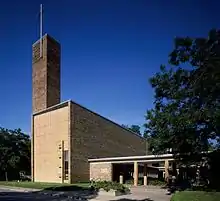
The Billy Graham Evangelistic Association was headquartered in Minneapolis from the late 1940s into the early 2000s.[103] Jim Bakker and Tammy Faye met while attending the Pentecostal North Central University and began a television ministry that by the 1980s reached 13.5 million households.[104] As of 2012, Mount Olivet Lutheran Church in southwest Minneapolis was the nation's second-largest Lutheran congregation, with about 6,000 attendees.[105] Christ Church Lutheran in the Longfellow neighborhood, designed by Eliel Saarinen with an education building by his son Eero Saarinen, is a National Historic Landmark.[106]
During the 1950s, members of the Nation of Islam created a temple in north Minneapolis,[107] and the first Muslim mosque was built in 1967.[108] In 1972 a relief agency resettled the first Shi'a Muslim family from Uganda in the Twin Cities.[109] As of 2017, the 28,000 to 120,000 Somalis who live in the city are primarily Sunni Muslim.[110] The city has about 20 Buddhist and meditation centers.[111] Atheists For Human Rights has its headquarters in the Shingle Creek neighborhood in a geodesic dome.[112] Minneapolis has a body of Ordo Templi Orientis.[113] The first Hindu temple in the city was built in 1978, and North America's largest as of 2010, the Hindu Temple of Minnesota, is in Maple Grove.[114]
Economy
| Top publicly traded Minneapolis companies for 2020 with city and US ranks Source: Fortune 500[115] | |||||||
| Mpls | Corporation | US | Revenue (in millions) | ||||
| 1 | Target Corporation | 37 | $78,112 | ||||
| 2 | U.S. Bancorp | 113 | $27,325 | ||||
| 3 | Ameriprise Financial | 245 | $13,103 | ||||
| 4 | Xcel Energy | 276 | $11,529 | ||||
| 5 | Thrivent | 368 | $8,612 | ||||
| Top Minneapolis employers in 2018 Source: Twin Cities Business[116] | |||||||
| Rank | Company/Organization | ||||||
| 1 | Target Corporation | ||||||
| 2 | Hennepin Healthcare | ||||||
| 3 | Wells Fargo | ||||||
| 4 | Hennepin County | ||||||
| 5 | Ameriprise Financial | ||||||
| 6 | U.S. Bancorp | ||||||
| 7 | Xcel Energy | ||||||
| 8 | City of Minneapolis | ||||||
| 9 | RBC Wealth Management | ||||||
| 10 | Thrivent | ||||||
As of 2020, Minneapolis–St. Paul area is the second largest economic center in the Midwest, behind Chicago.[117] During the city's formative years, millers had to pay cash for wheat during the growing season and then hold it until it was needed for flour. This required large amounts of capital, which stimulated the local banking industry and made Minneapolis a major financial center.[118] The economy of Minneapolis today is based in commerce, finance, rail and trucking services, health care, and industry. Smaller components are in publishing, milling, food processing, graphic arts, insurance, education, and high technology.[119]
The Twin Cities metropolitan area has the fifth highest concentration of major corporate headquarters in the country as of 2018,[120] and in 2020, five Fortune 500 corporations were headquartered within the city limits of Minneapolis.[115] Foreign companies with US offices in Minneapolis include Accenture, Bellisio Foods (now part of Charoen Pokphand Foods),[121] Canadian Pacific, Coloplast,[122] RBC[123] and Voya Financial.[124] In its 2018 survey based on 2017 cost of living for expatriate executives, The Economist ranked Minneapolis the third-most expensive city in North America and 26th in the world.[125]
As of 2020, the Minneapolis metropolitan area contributes $273 billion or 74% to the gross state product of Minnesota.[126] Measured by gross metropolitan product per resident ($62,054), as of 2015, Minneapolis is the fifteenth richest city in the US.[127] In 2011, the area's $199.6 billion gross metropolitan product and its per capita personal income ranked thirteenth in the US.[128]
The Federal Reserve Bank of Minneapolis serves Minnesota, Montana, North and South Dakota, and parts of Wisconsin and Michigan, the smallest population of the twelve regional banks in the Federal Reserve System.[129] Along with supporting consumers and the community, the bank executes monetary policy, regulates the banks in its territory, provides cash, and oversees electronic deposits.[130] The Minneapolis Grain Exchange, founded in 1881, is still located near the riverfront and is the only exchange for hard red spring wheat futures and options.[131]
Culture
Visual arts
The Walker Art Center, one of the five largest modern art museums in the US, sits atop Lowry Hill, near downtown. The size of the center doubled with an addition in 2005 by Herzog & de Meuron, and expanded with a 15-acre (6.1 ha) park designed by Michel Desvigne, located across the street from the Minneapolis Sculpture Garden.[133]
Known as Mia since its 100th anniversary, the Minneapolis Institute of Art, designed by McKim, Mead & White in 1915 in south central Minneapolis, is the largest art museum in the city, with 100,000 pieces in its permanent collection. New wings, designed by Kenzo Tange and Michael Graves, opened in 1974 and 2006, respectively, for contemporary and modern works, as well as more gallery space.[134]
The Weisman Art Museum, designed by Frank Gehry for the University of Minnesota, opened in 1993 and offers free admission.[135] An 2011 addition by Gehry doubled the size of the galleries.[136] The Museum of Russian Art opened in a restored church in 2005 and hosts a collection of 20th-century Russian art as well as special events.[137]
The Northeast Minneapolis Arts District has 400 independent artists, a center at the Northrup-King Building, and recurring annual events.[138]
Theater and performing arts
Minneapolis has hosted theatrical performances since after the Civil War.[139] Early theaters included the Pence Opera House,[139] the Academy of Music, the Grand Opera House, the Lyceum, and later the Metropolitan Opera House, which opened in 1894.[140] As of 2020 Minneapolis is home to dozens of theater companies.[141]
The Guthrie Theater, the area's largest theater company, occupies a three-stage complex overlooking the Mississippi, designed by French architect Jean Nouvel.[134] The company was founded in 1963 by Sir Tyrone Guthrie as a prototype alternative to Broadway, and it produces a wide variety of shows throughout the year.[142][143] Minneapolis purchased and renovated the Orpheum, State, and Pantages Theatres vaudeville and film houses on Hennepin Avenue, which are now used for concerts and plays.[144] A fourth renovated theater, the former Shubert, joined with the Hennepin Center for the Arts to become the Cowles Center for Dance and the Performing Arts, home to more than one dozen performing arts groups.[145][146]
Music
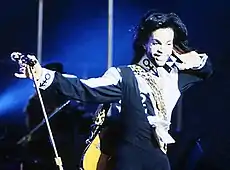
The Minnesota Orchestra plays classical and popular music at Orchestra Hall under music director Osmo Vänskä[149] The orchestra was nominated in 2013 for its recording of "Sibelius: Symphonies Nos. 2 & 5," and it won a Grammy Award in 2014 for "Sibelius: Symphonies Nos 1 & 4."[150][151]
According to DownBeat, for 25 years the Dakota Jazz Club has been one of the world's best jazz venues. [152]
Singer and multi-instrumentalist Prince was born in Minneapolis and lived in the area most of his life.[153] After Jimmy Jam and the 11-piece Mind & Matter broke through discrimination that had created a race barrier downtown, Prince reached a global multiracial audience with his combination of indecency and religion.[154] An authentic musical prodigy enriched by a music program at The Way Community Center, Prince learned to operate a Polymoog at Sound 80 for his first album that became a sonic element of the Minneapolis sound.[155] With fellow local musicians, many of whom recorded at Twin/Tone Records,[156] Prince helped make First Avenue and the 7th Street Entry prominent venues for both artists and audiences.[157]
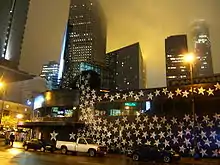
Hüsker Dü and The Replacements were pivotal in the US alternative rock boom during the 1980s. Their respective frontmen Bob Mould and Paul Westerberg developed successful solo careers.[159] The MN Spoken Word Association and independent hip hop label Rhymesayers Entertainment have garnered attention for rap, hip hop and spoken word.[160] Underground Minnesota hip hop acts such as Atmosphere and Manny Phesto comment about the city and Minnesota in song lyrics.[161][162]
Tom Waits released two songs about the city, "Christmas Card from a Hooker in Minneapolis" (Blue Valentine, 1978) and "9th & Hennepin" (Rain Dogs, 1985), and Lucinda Williams recorded "Minneapolis" (World Without Tears, 2003). Electronic dance music artists include Woody McBride,[163] Freddy Fresh[164] and DVS1.[165] In 2008, the century-old MacPhail Center for Music opened a new facility designed by James Dayton.[166] Minneapolis has four opera companies: Minnesota Opera, Mill City Summer Opera, the Gilbert & Sullivan Very Light Opera Company, and Really Spicy Opera.[167]
Charity
Philanthropy and charitable giving are part of the community.[168] According to AmeriCorps, in 2017 Minneapolis–Saint Paul ranked first among cities with 46.3% of the population volunteering.[169] The Minneapolis Foundation invests and administers over 1,000 charitable funds.[170]
Alight helps 2.5 million refugees and displaced persons each year in Asili-Democratic Republic of Congo, Jordan, Myanmar, Pakistan, Rwanda, Somalia, South Sudan, Sudan, Syria, Thailand and Uganda.[171] In the state, Catholic Charities USA is one of the largest providers of social services.[172]
Cuisine
The non-profit Appetite for Change (AFC) administers ten gardens, sells produce at the West Broadway Farmers Market in summertime, supplies its restaurants, and gives away boxes of fresh produce.[173] AFC's goal is to improve the local diet against an influx of fast-food stores.[174] West Broadway Avenue was a cultural epicenter during the early 20th century but by the 1950s, flight to the suburbs began, and streetcars closed down.[175] One of the largest urban food deserts in the US was in North Minneapolis, where, as of mid-2017, 70,000 people had only two grocery stores.[176] Wirth Co-op since opened in 2017 but closed within a year. North Market opened in 2017.[177][178]

As of 2019, Minneapolis-based chefs have won James Beard Foundation Awards: Ann Kim, chef at Young Joni, Pizza Lola and Hello Pizza, won in 2019.[180] Founder of the Sioux Chef, Sean Sherman won two James Beard prizes in 2019—the leadership award and best cookbook. Steve Hoffman won the James Beard distinguished writing award for "What Is Northern Food?."[181] Other winners were 2008 rising star chef Gavin Kaysen who won again in 2018 at Spoon & Stable; Alexander Roberts at Restaurant Alma; and Isaac Becker at 112 Eatery. Also in venues that have closed, Tim McKee won at La Belle Vie, and Paul Berglund at Bachelor Farmer.[182][183] Andrew Zimmern won in 2010, 2013 and 2017 for Outstanding Personality/Host on Bizarre Foods with Andrew Zimmern and for his television program On Location in 2012.[184] When thirteen chefs and restaurants were nominated for James Beard awards in 2017, The Wall Street Journal named Minneapolis one of the ten best places to visit in the world.[185]
Both credible originators of the burger, the 5-8 Club and Matt's Bar have served the Jucy Lucy since the 1950s.[186] East African cuisine arrived with a wave of Somali immigration which started in the 1990s.[187] Young Joni was selected one of the GQ top ten new restaurants and one of Eater's twelve best new restaurants of 2017.[188][189] Esquire put Hai Hai on its list of America's best restaurants in 2018.[190] In 2018, Food & Wine named Spoon and Stable one of the 40 most important restaurants of the past 40 years.[191] As of 2019, chefs and bakers at eight of nine Kim Bartmann Minneapolis restaurants used heritage grains from Sunrise Four Mill.[192]
Annual events
Year-round events include the City of Lakes Loppet, a 22-mile (35 km) cross-country ski race in February; the MayDay Parade is returning in 2021; Art-A-Whirl; Pride Festival & Parade, Stone Arch Bridge Festival, and Twin Cities Juneteenth Celebration in June; Minneapolis Aquatennial in July; Minnesota Fringe Festival, Loring Park Art Festival, Uptown Metris Art Fair, Powderhorn Festival of Arts and the Lake Hiawatha Neighborhood Festival in August; Minneapolis Monarch Festival in September to celebrate the Monarch butterfly's 2,300-mile (3,700 km) migration; and the Twin Cities Marathon in October.[193]
Sports
| Team | Sport | League | Since | Venue (capacity) | Championships |
|---|---|---|---|---|---|
| Minnesota Lynx | Basketball | Women's National Basketball Association | 1999 | Target Center (18,798) | 2011, 2013, 2015, 2017 |
| Minnesota Timberwolves | Basketball | National Basketball Association | 1989 | Target Center (18,798) | |
| Minnesota Twins | Baseball | Major League Baseball | 1961 | Target Field (39,500) | 1987, 1991 |
| Minnesota Vikings | American football | National Football League | 1961 | U.S. Bank Stadium (66,655)[194] | 1969 (NFL) |
Minneapolis is home to four professional sports teams. The Minnesota Vikings football team and the Minnesota Twins baseball team have played in the state since 1961. The Vikings were an NFL expansion team, and the Twins were formed when the Washington Senators relocated to Minnesota.[195] The Twins won the World Series in 1987 and 1991 and have played at Target Field since 2010. The Vikings played in the Super Bowl following the 1969, 1973, 1974, and 1976 seasons, losing all four games. The Minnesota Timberwolves brought NBA basketball back to Minneapolis in 1989, followed by the Minnesota Lynx in 1999. Both basketball teams play in the Target Center.
In recent years, the Lynx have been the most successful sports team in the city and a dominant force in the WNBA, reaching the WNBA Finals in 2011, 2012, 2013, 2015, 2016, and 2017 and winning in 2011, 2013, 2015 and 2017.[196]
The 1,750,000-square-foot (163,000 m2) U.S. Bank Stadium was built for the Vikings for about $1.122 billion, with $348 million coming from the state of Minnesota and $150 million coming from the city of Minneapolis. Called "Minnesota's biggest-ever public works project," the stadium opened in 2016 with 66,000 seats, expandable to 70,000 for the 2018 Super Bowl.[197] U.S. Bank Stadium also hosts indoor running and rollerblading nights, as well as concerts and events.[198]
Major sporting events hosted by the city include baseball All-Star Games, World Series, Super Bowls, NCAA Division 1 men's and women's basketball Final Four, the AMA Motocross Championship, the X Games and the WNBA All-Star Game.[199]
The Gophers women's ice hockey team is a six-time NCAA champion and seven-time national champion winning in 2000, 2004, 2005, 2012, 2013, 2015, and 2016.[200][201]
The Minnesota Wild of the NHL play at the Xcel Energy Center,[202] and the MLS soccer team Minnesota United FC play at Allianz Field, both in Saint Paul.[203] In other sports, six golf courses are located within city limits.[204] While living in Minneapolis, Scott and Brennan Olson founded (and later sold) Rollerblade, the company that popularized the sport of inline skating.[205]
Parks and recreation

The Minneapolis park system has been called[lower-alpha 4] the best-designed, best-financed, and best-maintained in America.[207] More than a century after the system was designed, in its 2020 ParkScore ranking, The Trust for Public Land reported that Minneapolis had the best park system among the 100 most populous US cities.[208]
The parks are governed and operated by the Minneapolis Park and Recreation Board, an independent park district with broader powers than any other parks agency in the country.[209] Foresight, donations and effort by community leaders enabled Horace Cleveland to create his finest landscape architecture, preserving geographical landmarks and linking them with boulevards and parkways.[210] The city's Chain of Lakes, consisting of seven lakes and Minnehaha Creek, is connected by bike, running, and walking paths and used for swimming, fishing, picnics, boating, and ice skating. A parkway for cars, a bikeway for riders, and a walkway for pedestrians runs parallel along the 52-mile (84 km) route of the Grand Rounds National Scenic Byway.[211] Theodore Wirth is credited with developing the parks system.[212] Approximately 15% of city land is parks, in accordance with the 2020 national median, and 98 percent of residents live within a half mile of a park.[208] Gaining criticism, the park board allocated more of its 2020–2021 budget to park police than to youth development.[213]
.jpg.webp)
Parks are interlinked in many places and the Mississippi National River and Recreation Area connects regional parks and visitor centers. The country's oldest public wildflower garden, the Eloise Butler Wildflower Garden and Bird Sanctuary, is located within Theodore Wirth Park. Wirth Park is shared with Golden Valley and is about 90% the size of Central Park in New York City.[214] Site of the 53-foot (16 m) Minnehaha Falls, Minnehaha Park is one of the city's oldest and most popular parks.[215] The regional park received over 2,050,000 visitors in 2017.[216] Henry Wadsworth Longfellow named Hiawatha's wife Minnehaha for the Minneapolis waterfall in The Song of Hiawatha, a bestselling and often-parodied 19th century poem.[217] The five-mile, hiking-only Winchell Trail along the Mississippi River, with its gorge views and access, offers a rustic hiking experience.[218]
The Medtronic Twin Cities Marathon is a Boston qualifier.[219]
Government
Minneapolis is a stronghold for the Minnesota Democratic–Farmer–Labor Party (DFL), an affiliate of the Democratic Party. The Minneapolis City Council represents the city's thirteen districts called wards. The city adopted instant-runoff voting in 2006, first using it in the 2009 elections.[220] The council is progressive with twelve DFL members and one from the Green Party.[221]
Jacob Frey of the DFL was elected mayor of Minneapolis in 2017.[222] The office of mayor is relatively weak but has some power to appoint individuals such as the chief of police. Parks, taxation, and public housing are semi-independent boards and levy their own taxes and fees subject to Board of Estimate and Taxation limits.[223] Elected in 2013, Lisa Bender serves as president of the City Council and does not plan to seek reelection.[224]
In December 2020, the city worked through input from nearly a thousand residents, an upturn in the crime rate, COVID-19, and the threat of a mayoral veto, to reach agreement on a 2021 budget. The $1.5 billion compromise maintained the number of police officers, set aside $8 million for community safety measures, cut funding in all major city departments, and included a 5.75 percent property tax increase.[225]
At the federal level, Minneapolis proper sits within Minnesota's 5th congressional district, which has been represented since 2018 by Democrat Ilhan Omar, one of the first two practicing Muslim women and the first Somali-American in Congress. Both of Minnesota's US Senators, Amy Klobuchar and Tina Smith, were elected or appointed while living in Minneapolis and are also Democrats.[226]
The Republican Party of Minnesota in 2014 moved its state headquarters from Saint Paul to the Seward neighborhood of Minneapolis.[227]
The City Council passed a resolution in 2015 making fossil fuel divestment city policy,[228] joining seventeen cities worldwide in the Carbon Neutral Cities Alliance. The city's climate plan calls for an 80 percent reduction in greenhouse gas emissions by 2050.[229]
Police
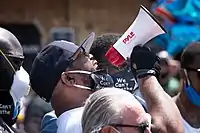
Minneapolis has a separation ordinance that directs local law enforcement officers not to 'take any law enforcement action' for the sole purpose of finding undocumented immigrants, nor ask an individual about his or her immigration status.[230]
Killings of citizens by Minneapolis police occur repeatedly. The police caused ten deaths in the decade preceding the killing of George Floyd,[231] and in 2021, Star Tribune counted 200 police-related deaths in the state this century.[232]
Police chief Medaria Arradondo was part of a $740,000 settlement after accusing the department of "a history of tolerating racist and discriminatory remarks by its white police officers."[233] Body cameras were introduced in 2016 by former chief Janée Harteau but they were rarely used. A city audit in 2019 found body camera activation eventually increased to 95% since a 2017 order from Arradondo.[234] The police union viewpoint protects officers with a legal doctrine of qualified immunity.[233] MPD150, a community coalition formed at the department's 150th anniversary, holds a different view that the department should be abolished.[235]
City council president Bender announced in 2020 that the city should dismantle its police department and replace it with a "transformative new model of public safety."[236] However, the Charter Commission rejected the proposal.[237] In December, the City Council voted to move $8 million from police to dispatcher training and mental health crisis teams, and more narrowly, they voted to maintain the level of police staffing at 888 for 2021. After the summer of 2020, the department lost 166 officers either to retirement or to temporary leave, many with PTSD, and a crime wave resulted in more than 500 shootings.[238]
Education
Primary and secondary education
Minneapolis Public Schools enroll over 35,000 students in public primary and secondary schools. The district administers about one hundred public schools including forty-five elementary schools, seven middle schools, seven high schools, eight special education schools, eight alternative schools, nineteen contract alternative schools, and five charter schools. With authority granted by the state legislature, the school board makes policy, selects the superintendent, and oversees the district's budget, curriculum, personnel, and facilities. In 2017, the graduation rate was 66 percent.[239] Students speak over one hundred different languages at home and most school communications are printed in English, Hmong, Spanish, and Somali.[240][241] Some students attend public schools in other school districts chosen by their families under Minnesota's open enrollment statute.[242] Besides public schools, the city is home to more than twenty private schools and academies and about twenty additional charter schools.[243]
Colleges and universities
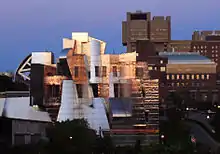
Minneapolis's collegiate scene is dominated by the main campus of the University of Minnesota where more than 50,000 undergraduate, graduate, and professional students attend twenty colleges, schools, and institutes.[244] The graduate school programs with exceptional national rankings in 2020 (top five) were health care management, nursing: midwifery, pharmacy and clinical psychology.[245]
Augsburg University, Minneapolis College of Art and Design, and North Central University are private four-year colleges. Minneapolis Community and Technical College and the private Dunwoody College of Technology provide career training. St. Mary's University of Minnesota has a Twin Cities campus for its graduate and professional programs. Two large principally online universities, Capella University and Walden University, are both headquartered in the city. The public four-year Metropolitan State University and the private four-year University of St. Thomas are among postsecondary institutions based elsewhere with campuses in Minneapolis.[246]
Libraries
Founded by T. B. Walker in 1885,[247] the Minneapolis Public Library merged with the Hennepin County Library system in 2008.[248] The new downtown Central Library designed by César Pelli opened in 2006.[249] Ten special collections hold over 25,000 books and resources for researchers, including the Minneapolis Collection and the Minneapolis Photo Collection.[250] About 845,000 people have free library cards.[251]
Media
Several newspapers are published in Minneapolis: Star Tribune, Finance & Commerce, Minnesota Spokesman-Recorder, the university's The Minnesota Daily, and MinnPost.com. TMC Publications publishes The Monitor and Longfellow Nokomis Messenger.[252] MSP Communications publishes Mpls.St.Paul and Twin Cities Business magazines.[253] Other publications include Minnesota Women's Press, North News, Northeaster, Insight News, and The Circle.[252]
Nineteen FM and AM radio stations are licensed to Minneapolis, including one from the University of Minnesota and one from the public schools. Up to 79 FM and AM signals can be received in one or more areas of the city. There are 10 full-power television stations in the metro area, and one non-profit public access cable network. WCCO-TV is based in Minneapolis proper. A majority of these signals can be streamed.[254]
Movies filmed in Minneapolis include Airport (1970),[255] The Heartbreak Kid (1972),[256] Slaughterhouse-Five (1972),[257] Ice Castles (1978),[258] Foolin' Around (1980),[259] Take This Job and Shove It (1981),[260] Purple Rain (1984),[261] That Was Then, This Is Now (1985),[262] The Mighty Ducks (1992),[263] Untamed Heart (1993),[264] Little Big League (1994),[265] Beautiful Girls (1996),[266] Jingle All the Way (1996),[267] Fargo (1996),[268] and Young Adult (2011).[269] In 1960s television, two episodes of Route 66 were made in Minneapolis. The 1970s CBS situation comedy fictionally based in Minneapolis, The Mary Tyler Moore Show, won three Golden Globes[270] and 29 Emmy Awards.[271] The show's opening sequences were shot locally.
Infrastructure
Transportation

Minneapolis has two light rail lines and one commuter rail line. The Metro Blue Line connects the Mall of America and Minneapolis–Saint Paul International Airport in Bloomington to downtown and the Metro Green Line travels east from downtown through the University of Minnesota campus to downtown Saint Paul. Hundreds of homeless people nightly sought shelter on Green Line trains until overnight service was cut back in 2019 and rising crime on the light rail system led to discussion in the state legislature on how to best address the issue in 2020.[272][273] An extension of the Green Line will connect downtown Minneapolis with the southwestern suburbs and is expected to open in 2023.[274] An extension of the Blue Line to the northwest suburbs reentered the planning stages for a new route alignment in 2020.[275] The 40-mile Northstar Commuter rail runs from Big Lake through the northern suburbs and terminates at the multi-modal transit station at Target Field using existing railroad tracks.[276] Public transit ridership in the Twin Cities was 91.6 million in 2019, a three percent decline over the previous year which is part of a national trend in lower local bus ridership. Ridership on the Metro system remained steady or grew slightly.[277]
In 2007, the Interstate 35W bridge over the Mississippi, at the time overloaded with three hundred tons of repair materials, collapsed, killing thirteen and injuring 145 people. The bridge was rebuilt in fourteen months. Only one-fourth of the country's structurally deficient bridges had been repaired ten years later.[278]
Walk Score rated Minneapolis as having the 13th highest Walk Score and the highest Bike Score among cities with more than 200,000 people in the US in 2020.[279] The Minneapolis Skyway System, 9.5 miles (15.3 km) of enclosed pedestrian bridges called skyways, link 80 city blocks downtown with second floor restaurants and retailers open weekdays.[280] Bicycling named Minneapolis the 4th best bicycling city in 2018.[281] Off-street facilities include the Grand Rounds, Midtown Greenway, Little Earth Trail, Hiawatha LRT Trail, Kenilworth Trail, and Cedar Lake Trail.[282] Bicycle sharing provider Nice Ride Minnesota planned expanded capacity in 2019.[283]
Minneapolis–Saint Paul International Airport (MSP) serves international, domestic, charter and regional carriers[284] and is home base for Sun Country Airlines.[285] As of 2019, it is also the second-largest hub for Delta Air Lines, who operate more flights out of MSP than any other airline.[286] For terminals serving 25 to 40 million passengers, MSP was named the world's best airport for customer experience in North America in 2020 for the fourth consecutive year.[287] Forbes named MSP the second best airport in North America, behind Detroit in 2019.[288]
Health care
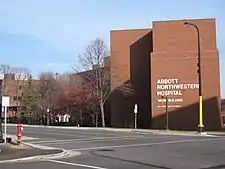
Minneapolis has eight hospitals, four ranked among America's best by U.S. News & World Report in 2020–2021—Abbott Northwestern Hospital, Children's Hospitals and Clinics, University of Minnesota Medical Center, and University of Minnesota Masonic Children's Hospital.[289] Hennepin Healthcare, Minneapolis VA Medical Center, Shriners Hospitals for Children and Phillips Eye Institute also serve the city.[290] The Mayo Clinic in Rochester is a 75-minute drive away.[291]
Cardiac surgery was developed at the university's Variety Club Hospital, where by 1957, more than two hundred patients had survived open-heart operations, many of them children. Working with surgeon C. Walton Lillehei, Medtronic began to build portable and implantable cardiac pacemakers about this time.[292]
Hennepin Healthcare opened in 1887 as City Hospital, and also has been known as Minneapolis General Hospital, Hennepin County General Hospital, and HCMC.[293] A public teaching hospital and Level I trauma center,[294] the Hennepin Healthcare safety net counted 643,739 clinic visits and 111,307 emergency and urgent care visits in 2019.[295]
The 2018 AARP Livability Index scored Minneapolis above average on health;[296] the American College of Sports Medicine (ACSM) ranked Minneapolis and its metropolitan area the nation's first, second, or third most fit city every year from 2008 to 2016, and first from 2011 to 2013.[297] The ACSM American Fitness Index ranks the city third in 2020.[298]
Utilities
Ambassadors of the Minneapolis Downtown Improvement District (DID) work on 120 blocks of downtown to improve its cleanliness, friendliness and acceptability of behavior. They are employees of Block by Block, a company in Nashville, Tennessee that serves forty-six US cities.[299]
Xcel Energy supplies electricity, CenterPoint Energy supplies gas, CenturyLink provides landline telephone service, and Comcast provides cable service.[300] The city treats and distributes water and charges a monthly solid waste fee for trash removal.[301]
After each significant snowfall, called a snow emergency, the Minneapolis Public Works Street Division plows over 1,000 mi (1,610 km) of streets and 400 mi (640 km) of alleys—counting both sides, the distance between Minneapolis and Seattle and back.[302] Ordinances govern parking on the plowing routes during these emergencies as well as snow shoveling.[303]
Notable people
Sister cities
Minneapolis' sister cities are:[304]
See also
Notes
- E. K. Soper, writing in 1915 before Minneapolis had reached its present size, described "several points which attain an altitude of 965 feet [294 m], or thereabouts" near the border with Columbia Heights.[60] Reporter John Carman gave 967 feet (295 m) at Deming Heights Park in the Waite Park neighborhood in a 1975 article.[61] The United States Geological Survey lists the highest elevation as 980 feet (300 m) but does not give a location.[59] Geography professor John Tichy described the highest point as being the site of Waite Park Elementary School at approximately 985 feet (300 m) above sea level.[62] All of the cited sources that list locations agree that the point is somewhere within Northeast section of the city.
- Mean monthly maxima and minima (i.e., the highest and lowest temperature readings during an entire month or year) calculated based on data at said location from 1981 to 2010.
- Official records for Minneapolis/St. Paul were kept by the St. Paul Signal Service in that city from January 1871 to December 1890, the Minneapolis Weather Bureau from January 1891 to April 8, 1938, and at KMSP since April 9, 1938.[74]
- In his textbook The American City: What Works, What Doesn't, Alexander Garvin writes that Minneapolis built "the best-located, best-financed, best-designed, and best-maintained public open space in America."[207]
References
- Harris, Marlyn (August 29, 2013). "With Minneapolis' weak-mayor system, does it really matter who gets elected?". MinnPost. Retrieved November 29, 2020.
- "2019 US Gazetteer Files". US Census Bureau. Retrieved July 26, 2020.
- "Metropolitan and Micropolitan Statistical Areas". US Census Bureau, Population Division. June 18, 2020. Retrieved November 29, 2020.
- "Population and Housing Unit Estimates". US Census Bureau. Retrieved December 1, 2020.
- "Metropolitan and Micropolitan Statistical Areas Population Totals: 2010–2018". 2018 Population Estimates. US Census Bureau, Population Division. May 28, 2019. Retrieved May 28, 2019.
- "Key Findings". MN State Demographic Center. and "NACo County Explorer: Hennepin County, MN". National Association of Counties. Retrieved December 21, 2020.
- "City and Town Population Totals: 2010–2019". US Census Bureau. Retrieved December 21, 2020.
- "Seven-county Twin Cities region surpassed 3 million people in 2015" (Press release). MN State Demographic Center. March 24, 2016. Retrieved December 22, 2020.
- "Revised Delineations of Metropolitan Statistical Areas, Micropolitan Statistical Areas, and Combined Statistical Areas, and Guidance on Uses of the Delineations of These Areas" (PDF). Office of Management and Budget. February 28, 2013. and "Metropolitan and Micropolitan Statistical Areas Population Totals and Components of Change: 2010–2019". US Census Bureau. Retrieved December 23, 2020.
- "2020 ParkScore Index". The Trust for Public Land. Retrieved May 20, 2020.
- "Minneapolis Flour Milling Boom". Minnesota Historical Society. Retrieved January 14, 2021.
- "Minneapolis–St. Paul in Dakota and Ojibwe". Decolonial Atlas. January 20, 2018. Retrieved November 29, 2020.
- Treaty of Paris (1783), Article 2. Wikisource. Retrieved December 3, 2020.
- Lass, William E. (1980). Minnesota's Boundary with Canada: Its Evolution Since 1783. Minnesota Historical Society. pp. 14–17. ISBN 978-0873511537.
- Watson, Catherine (September 16, 2012). "Ft. Snelling: Citadel on a Minnesota bluff". Los Angeles Times. Retrieved December 27, 2019.
- Wingerd, Mary Lethert (2010). North Country: The Making of Minnesota. University of Minnesota Press. pp. 4, 5, 33, 82, 159. ISBN 978-0816648689.
- "Historic Fort Snelling: The US Indian Agency (1820–1853)". Minnesota Historical Society. Retrieved December 27, 2019.
- "Treaties". and "Forced Marches & Imprisonment". and "Aftermath". Minnesota Historical Society. Retrieved January 17, 2021.
- "John H. Stevens House Museum". US National Park Service. Retrieved December 31, 2019.
- Baldwin, Rufus J.; Atwater, Isaac (1893). "Early Settlement," "History and Incidents of Banking," and "Pioneer Life in Minneapolis—From a Woman's Standpoint". In Atwater, Isaac (ed.). History of the City of Minneapolis, Minnesota. 1. Munsell & Company. pp. 29–48, 80, 498 [39]. OCLC 22047580. and Johnston, Daniel S. B. (1905). "Minnesota Journalism in the Territorial Period". Collections of the Minnesota Historical Society. 10. Minnesota Historical Society. pp. 261–262. OCLC 25378013. and Parsons, Ernest Dudley (1913). The Story of Minneapolis. Minneapolis: Colwell Press. pp. 52–53 – via Google Books.
- "A History of Minneapolis: Mdewakanton Band of the Dakota Nation, Parts I and II". Hennepin County Library. 2001. Archived from the original on April 9, 2012. and "The US-Dakota War of 1862". Minnesota Historical Society. and "A History of Minneapolis: Minneapolis Becomes Part of the United States". Archived from the original on April 21, 2012., and "A History of Minneapolis: Governance and Infrastructure". Archived from the original on April 21, 2012. and "A History of Minneapolis: Railways". Archived from the original on April 21, 2012. Retrieved January 1, 2020 – via Internet Archive.
- Frame, Robert M., III; Hess, Jeffrey (January 1990). "Historic American Engineering Record MN-16: West Side Milling District" (PDF). U.S. National Park Service. p. 2. Retrieved December 5, 2020.
- Hart, Joseph (June 11, 1997). "Lost City". City Pages. Archived from the original on November 4, 2013. Retrieved January 12, 2021.
- "History of Technology". historyworld.net. HistoryWorld. Retrieved April 4, 2007.
- Anfinson, Scott F. (1990). "Archaeology of the Central Minneapolis Riverfront Part 2: Archaeological Explorations and Interpretive Potentials, Chapter 4". The Minnesota Archaeologist. 49 (1–2). Retrieved January 7, 2021.
- Watts, Alison (Summer 2000). "The technology that launched a city: scientific and technological innovations in flour milling during the 1870s in Minneapolis" (PDF). Minnesota History. 57 (2): 86–97. JSTOR 20188202. Retrieved January 12, 2021.
- Danbom, David B. (2003). "Flour power: the significance of flour milling at the falls" (PDF). Minnesota History. 58 (5–6): 270–285. JSTOR 20188363. Retrieved October 29, 2013.
- "Crown Roller Mill: HAER No. MN-12" (PDF). Historic American Buildings Survey/Historic American Engineering Record. US Library of Congress. p. 10. Retrieved May 19, 2015.
- Nestle, Marion; Nesheim, Malden C. (2010). Feed Your Pet Right. Free Press (Simon & Schuster). pp. 322–323. ISBN 978-1-4391-6642-0. Retrieved December 7, 2020.
- "History". Mill City Museum. Archived from the original on May 13, 2007. Retrieved December 7, 2020 – via Internet Archive.
- Gray, James (1954). Business without Boundary: The Story of General Mills. University of Minnesota Press. pp. 33–34, 41. LCCN 54-10286.
- Atwater, Isaac (1893). History of the City of Minneapolis, Minnesota. Munsell. pp. 257–262. Retrieved April 23, 2007.
- Nathanson 2010, pp. 41–47.
- Nathanson, Iric (December 2, 2013). "Goodwin's 'The Bully Pulpit' spotlights the Shame of Minneapolis". MinnPost. Retrieved December 10, 2020.
- Nathanson 2010, p. 58.
- About 10,000 such covenants remain as of 2017, in: Furst, Randy (August 26, 2017). "Massive project works to uncover racist restrictions in Minneapolis housing deeds". Star Tribune. and Delegard, Kirsten; Ehrman-Solberg, Kevin (2017). "'Playground of the People'? Mapping Racial Covenants in Twentieth-century Minneapolis". Open Rivers: Rethinking the Mississippi. 6. doi:10.24926/2471190X.2820.
- Hatle, Elizabeth Dorsey; Vaillancourt, Nancy M. (Winter 2009–2010). "One Flag, One School, One Language: Minnesota's Ku Klux Klan in the 1920s" (PDF). Minnesota History. 61 (8): 360–371. JSTOR 40543955. and Chalmers, David Mark (1987). Hooded Americanism: The History of the Ku Klux Klan. Duke University Press. p. 149. ISBN 978-0-8223-0772-3. Retrieved July 5, 2018.
- Ladd-Taylor, Molly (Summer 2005). "Coping with a 'Public Menace': Eugenic Sterilization in Minnesota" (PDF). Minnesota History. 59 (6): 237–248. JSTOR 20188483. Retrieved October 1, 2018.
- Weber, Laura E. (Spring 1991). "'Gentiles Preferred': Minneapolis Jews and Employment 1920–1950" (PDF). Minnesota History. 52 (5): 166–182. JSTOR 20179243. Retrieved August 21, 2012.
- "A History of Minneapolis: Medicine". Hennepin County Library. 2001. Archived from the original on April 21, 2012. Retrieved December 7, 2020.
- "Truckers' Strike of 1934: Overview". Minnesota Historical Society. Retrieved January 12, 2021.
- Reichard, Gary W. (Summer 1998). "Mayor Hubert H. Humphrey" (PDF). Minnesota History. 56 (2): 50–67. JSTOR 20188091. Retrieved February 12, 2020.
- "Historical Census Statistics On Population Totals By Race, 1790 to 1990, and By Hispanic Origin, 1970 to 1990, For Large Cities And Other Urban Places In The United States". US Census Bureau. Archived from the original on August 12, 2012. Retrieved December 7, 2020.
- Nathanson 2010, p. 111.
- The Editors of Encyclopaedia Britannica. "The Riots of the Long, Hot Summer". Encyclopaedia Britannica. Retrieved December 9, 2020.
- Nathanson 2010, pp. 126–130.
- Harry Davis (February 21, 2003). Almanac. Twin Cities Public Television. and "American Indian Movement". Encyclopædia Britannica. 2012. Retrieved December 7, 2020.
- Weber 2020, p. 128.
- Hart, Joseph (May 6, 1998). "Room at the Bottom". City Pages. 19 (909). Archived from the original on April 1, 2010. Retrieved December 7, 2020.
- Taylor, Derrick Bryson (July 10, 2020). "George Floyd Protests: A Timeline". The New York Times. Retrieved August 8, 2020.
- MPR News Staff (August 24, 2020). "NPR special report: Summer of racial reckoning". MPR News. Retrieved December 7, 2020.
- "Lake Calhoun signs updated to include the lake's Dakota name, Bde Maka Ska". MPR News. October 3, 2015. Retrieved October 6, 2015.
- Wright, H. E., Jr. (1990). "Geologic History of Minnesota Rivers" (PDF). Minnesota Geological Survey Educational Series. 7: 3–4, 14. Retrieved November 16, 2020 – via South Washington Watershed District.
- Fremling, Calvin R. (2005). Immortal River: The Upper Mississippi in Ancient and Modern Times. University of Wisconsin Press. pp. 56–60. ISBN 9780299202941.
- "Minneapolis". emporis.com. Emporis Buildings. Archived from the original on April 23, 2007. Retrieved January 12, 2021.
- "Physical Environment". City of Minneapolis. p. 39. Retrieved January 12, 2021.
- "State of the City: Physical Environment" (PDF). Minneapolis Planning Division via Internet Archive. 2003. Archived from the original (PDF) on March 8, 2008. Retrieved March 4, 2013.
- Harms, G. F. (October 1959). Soil Survey of Scott County, Minnesota (PDF) (Report). Soil Conservation Service. p. 59. Archived (PDF) from the original on February 17, 2017. Retrieved January 28, 2021.
- "Elevations and Distances in the United States". United States Geological Survey. April 29, 2005. Archived from the original on January 16, 2008. Retrieved January 17, 2021.
- Soper, E. K. (1915). "The Buried Rock Surface and Pre-Glacial River Valleys of Minneapolis and Vicinity". The Journal of Geology. 23 (5): 444–460. doi:10.1086/622258.
- Carman, John (September 8, 1975). "Twin Cities: Different as night and day". Minneapolis Star. pp. 1B, 5B. Retrieved January 17, 2021 – via Newspapers.com.
- Tichy, John (July 18, 1996). "Waite Park School sits on Minneapolis' highest point". Star Tribune. p. E17. Retrieved January 17, 2021 – via Newspapers.com.
- "Neighborhoods". City of Minneapolis. and "Council Wards". City of Minneapolis. Retrieved November 12, 2020.
- "City Council approves Minneapolis 2040 plan". Minnesota Spokesman-Recorder. December 7, 2018. and Grabar, Henry (December 7, 2018). "Minneapolis Confronts Its History of Housing Segregation". Slate. and Trickey, Erick. "How Minneapolis Freed Itself From the Stranglehold of Single-Family Homes". Politico. Retrieved December 16, 2020.
- Schuetz, Jenny (December 12, 2018). "Minneapolis 2040: The most wonderful plan of the year". Brookings Institution. Retrieved October 15, 2019.
- "Climate Minneapolis – Minnesota". US Climate Data (usclimatedata.com). Retrieved December 7, 2020.
- Peel, M. C.; Finlayson, B. L.; McMahon, T. A. (October 2007). "Updated world map of the Köppen-Geiger climate classification". Hydrology and Earth System Sciences. 11 (5): 1633–1644. Bibcode:2007HESS...11.1633P. doi:10.5194/hess-11-1633-2007.
- "Normals, Means, and Extremes for Minneapolis/Saint Paul" (PDF). NCDC Asheville, NC. 1971–2000. Archived from the original (PDF) on July 20, 2010. Retrieved December 7, 2020 – via Internet Archive.
- Pioneer Press staff (January 24, 2012). "USDA: Milder winters mean some changes in plant hardiness zones". St. Paul Pioneer Press. Archived from the original on July 21, 2016. Retrieved December 7, 2020.
- "USDA Plant Hardiness Zone Map". Agricultural Research Service, US Department of Agriculture. 2012. Archived from the original on February 27, 2014. Retrieved August 14, 2016.
- "Ranking of Cities Based on % Annual Possible Sunshine". NOAA: National Climatic Data Center. 2004. Retrieved January 1, 2015.
- Fisk, Charles (February 11, 2011). "Graphical Climatology of Minneapolis-Saint Paul Area Temperatures, Precipitation, and Snowfall". Retrieved February 18, 2011.
- "Twin Cities Area total monthly and seasonal snowfall in inches [1883–2016]". Minnesota Department of Natural Resources (DNR). Applied Climate Information System (ACIS), National Oceanic and Atmospheric Administration (NOAA). Retrieved September 9, 2016.
- "Threaded Station Extremes (Long-Term Station Extremes for America)". Regional Climate Centers (Cornell). Retrieved March 26, 2018.
- "NowData – NOAA Online Weather Data". National Oceanic and Atmospheric Administration. Retrieved April 12, 2016.
- "Station Name: MN MINNEAPOLIS/ST PAUL AP". National Oceanic and Atmospheric Administration. Retrieved March 25, 2014.
- "WMO climate normals for Minneapolis/INT'L ARPT, MN 1961–1990". National Oceanic and Atmospheric Administration. Retrieved July 18, 2020.
- "QuickFacts Minneapolis city, Minnesota: Race and Hispanic Origin". US Census Bureau. 2019. Retrieved November 11, 2020.
- "Minneapolis (city), Minnesota". State & County QuickFacts. US Census Bureau. Archived from the original on April 20, 2012. Retrieved April 21, 2012.
- "Race and Hispanic Origin for Selected Cities and Other Places: Earliest Census to 1990". US Census Bureau. Archived from the original on August 12, 2012. Retrieved April 21, 2012.
- US Census Bureau. "Census of Population and Housing". Retrieved May 21, 2014.
- Jerabek, Esther (1934). "The transition of a new-world Bohemia" (PDF). Minnesota History. 15 (1): 26–42. JSTOR 20161092. Retrieved May 10, 2020.
- Anderson, G.R., Jr. (October 1, 2003). "Living in America". City Pages. Archived from the original on April 7, 2008. Retrieved April 29, 2008.
- Biroczi, David (January 22, 2010). Czechs in America: The Maintenance of Czech Identity in Contemporary America (English ed.). Düsseldorf: Lambert Academic Publishing. pp. 96 pages. ISBN 978-3838334233.
- Nathanson, Iric. "Jews in Minnesota" (PDF). Jewish Community Relations Council. Archived from the original (PDF) on December 28, 2006. Retrieved April 14, 2007.
- Boyd, Cynthia (June 18, 2013). "Asians fastest-growing ethnic group in Minnesota". Twin Cities Daily Planet. Retrieved December 22, 2020.
- Smith, Kelly (March 11, 2017). "Indian families in Minnesota are on edge after U.S. attacks". Star Tribune. Retrieved December 22, 2020.
- Biewen, John (August 19, 1997). "Moving Up: Part One". Minnesota Public Radio. Retrieved December 7, 2020.
- "A History of Minneapolis: 20th Century Growth and Diversity". Hennepin County Library. 2001. Archived from the original on April 21, 2012. Retrieved December 7, 2020.
- Weber 2020, p. 159.
- Singer, Audrey (December 1, 2015). "Metropolitan immigrant gateways revisited, 2014". Brookings Institution. Retrieved November 11, 2020.
- BMTN Staff (March 8, 2018) [March 20, 2015]. "Survey: Twin Cities LGBT population one of lowest among US metro areas". Bring Me the News. Retrieved December 7, 2020.
- "Municipal Equality Index". Human Rights Campaign. 2019. Retrieved November 11, 2020.
- Guo, Jeff (February 17, 2015). "If Minneapolis is so great, why is it so bad for African Americans?". The Washington Post. Retrieved November 20, 2020.
- Hinton, Elizabeth (May 29, 2020). "The Minneapolis Uprising in Context". Boston Review. and Cheney-Rice, Zak (May 29, 2020). "There's Nothing Confusing Here". New York Magazine. Retrieved December 16, 2020.
- Holder, Sarah (June 5, 2020). "Why This Started in Minneapolis". Bloomberg CityLab. Retrieved January 2, 2021.
- "Major U.S. metropolitan areas differ in their religious profiles". pewforum.org. July 29, 2015. Retrieved December 29, 2019.
- "A History of Minneapolis: Religion". Hennepin County Library via Internet Archive. Archived from the original on April 23, 2012. Retrieved January 24, 2016.
- "Our Lady of Lourdes Catholic Church". Yahoo! Travel. Retrieved April 30, 2007.
- FitzGerald, Thomas E. (1998). The Orthodox Church. Praeger/Greenwood. ISBN 978-0-275-96438-2. and "About St. Mary's". St. Mary's Orthodox Cathedral. 2006. Retrieved March 19, 2007.
- Millet, Larry (2007). AIA Guide to the Twin Cities: The Essential Source on the Architecture of Minneapolis and St. Paul. Minnesota Historical Society. p. 84. ISBN 978-0-87351-540-5.
- Millett, Larry (2007). AIA Guide to the Twin Cities: The Essential Source on the Architecture of Minneapolis and St. Paul. Minnesota Historical Society Press. pp. 159–160. ISBN 978-0-87351-540-5.
- "Billy Graham and the Billy Graham Evangelistic Association — Historical Background". Billy Graham Center. November 11, 2004. Archived from the original on February 27, 2007 – via Internet Archive. and "Timeline of Historic Events". Billy Graham Evangelistic Association. Retrieved December 16, 2020.
- Camhi, Leslie (July 23, 2000). "FILM; The Fabulousness Of Tammy Faye". The New York Times. Retrieved February 11, 2017.
- Austin, Charles M. (August 2013). "20 Largest ELCA congregations in 2012". The Lutheran. Retrieved November 22, 2015.
- "Eliel Saarinen". Encyclopædia Britannica. and "Koulun sijainti / School location". Finnish Language School of Minnesota. Archived from the original on September 29, 2007. Retrieved August 7, 2007.
- "About Us". Masjid An-Nur. Retrieved February 8, 2014.
- Wiese, Gloria J. "History of North Minneapolis". Youth Resources. Archived from the original on January 16, 2014. Retrieved January 16, 2014.
- Barlow, Philip & Silk, Mark (2004). Religion and public life in the midwest: America's common denominator?. Rowman Altamira. p. 139. ISBN 978-0-7591-0631-4.
- "Somalis". International Institute of Minnesota. January 2017. Retrieved December 16, 2020.
- "Dainin Katagiri Lineage". Sweeping Zen. Archived from the original on June 5, 2012. and "United States Dharma Centers: Minnesota: Minneapolis". DharmaNet. Archived from the original on November 30, 2012. and "Directory of Religious Centers". President and Fellows of Harvard College and Diana Eck. Archived from the original on May 18, 2013. Retrieved December 16, 2020 – via Internet Archive.
- "Welcome to the Hub of Atheism!". AFHR (Atheists for Human Rights). December 4, 2011. Archived from the original on October 25, 2011. Retrieved December 13, 2020 – via Internet Archive.
- "Leaping Laughter Lodge". Leaping Laughter Oasis. Retrieved June 2, 2011.
- "Hindus in Minnesota". Star Tribune. December 2, 2010. Retrieved December 13, 2020.
- "Fortune 500 Companies". Fortune. 2020. Retrieved December 1, 2020.
- Ostuni, Amanda (February 14, 2019). "Target Retains Crown as Top Employer in Minneapolis". Twin Cities Business. Retrieved December 1, 2020.
- See Cook, Minneapolis, and Wayne metros in "GDP by County, Metro, and Other Areas". Bureau of Economic Analysis. December 9, 2020. Retrieved December 27, 2020.
- Lass, William E. (2000). Minnesota: A History. Norton. p. 164. ISBN 978-0-393-31971-2.
- "Minneapolis: The contemporary city". Encyclopædia Britannica. 2007. Retrieved March 24, 2007.
- Sauter, Michael B.; Stebbins, Samuel (November 1, 2018). "Fortune 500 companies list: 1 out of 3 are located in just six major cities". USA Today. Retrieved January 18, 2021.
- St. Anthony, Neal (November 17, 2016). "Minneapolis-based Bellisio Foods sells for $1.08 billion to Thailand company". Star Tribune. Retrieved November 19, 2016.
- "Saint Paul — Governor Tim Pawlenty announced today that Coloplast will move its North American corporate headquarters to Minnesota beginning this fall" (Press release). Coloplast Group. July 5, 2006. Retrieved January 20, 2010.
- "Our Company". RBC Wealth Management. Retrieved January 24, 2016.
- Black, Sam (April 7, 2014). "ING rebrands Minneapolis unit as Voya Financial". Minneapolis/St. Paul Business Journal. American City Business Journals. Retrieved July 5, 2014.
- Pheifer, Pat; Ramstad, Evan (March 20, 2018). "Report calling Minneapolis third-most expensive US city leaves out house prices". Star Tribune. and Data Team (March 15, 2018). "Asian and European cities compete for the title of most expensive city". The Economist. Retrieved January 18, 2021.
- "The urban prairie". The Economist Newspaper. July 23, 2020. Retrieved December 27, 2020.
- Donaldson, Ali & Lu, Wei (November 5, 2015). "These Are the 20 Richest Cities in America". Bloomberg L.P. Retrieved November 6, 2015.
- "Gross Metropolitan Product". Greyhill Advisors. Retrieved October 7, 2011.
- Misa, Thomas J. (2013). Digital State: The Story of Minnesota's Computing Industry. University of Minnesota Press. p. 260. ISBN 9780816688364. Retrieved January 18, 2021 – via Google Books.
- Chen, James (December 17, 2020). "Federal Reserve Bank of Minneapolis". Investopedia. Retrieved January 18, 2021.
- "Buyers & Processors". North Dakota Wheat Commission. Archived from the original on October 11, 2007. Retrieved April 2, 2007.
- "Collection". Minneapolis Institute of Art. Retrieved December 25, 2017.
- "Minneapolis Sculpture Garden". Archived from the original on February 5, 2007. Retrieved March 18, 2007.
- Joubert, Claire (May 2006). "Boom Town" (PDF). Mpls.St.Paul Magazine. Archived from the original (PDF) on June 15, 2007. Retrieved March 21, 2007 – via Meet Minneapolis.
- "Visit". Weisman Art Museum. Retrieved February 4, 2018.
- Kerr, Euan (October 2, 2011). "Weisman celebrates reopening with its designer in attendance". Minnesota Public Radio. Retrieved January 14, 2012.
- "History: TMORA". The Museum of Russian Art. September 30, 2015.
- "Northeast Minneapolis Named Best Art District". USA TODAY 10Best. Retrieved April 5, 2015.
- Wilmeth, Don B.; Miller, Tice L. (1996). The Cambridge Guide to American Theatre. Cambridge University Press. pp. 260–. ISBN 978-0-521-56444-1.
- Blegen, Theodore Christian (1975). Minnesota: A History of the State. University of Minnesota Press. pp. 505–. ISBN 978-0-8166-0754-9.
- "Minnesota Theaters". Minnesota Theater Alliance. Archived from the original on May 28, 2020. Retrieved January 1, 2021.
- Myers, Joseph (2004). "Guthrie Theatre". The Journal of the Acoustical Society of America. 115 (5): 2478. Bibcode:2004ASAJ..115Q2478M. doi:10.1121/1.4809325. Archived from the original on March 9, 2007.
- "Theater History". Guthrie Theater. Archived from the original on April 23, 2007. Retrieved April 23, 2007.
- "Theatre History". Hennepin Theatre Trust. Archived from the original on March 29, 2007. Retrieved March 17, 2007.
- Preston, Rohan (September 8, 2011). "Cowles Center: Big leap for Twin Cities arts". Star Tribune. Archived from the original on July 7, 2017. Retrieved September 9, 2011.
- LeFevre, Camille (June 30, 2010). "Shubert renamed Cowles Center for Dance and Performing Arts". MinnPost. Archived from the original on August 19, 2010. Retrieved August 21, 2010.
- Palmer, Caroline (May 5, 2016). "Dancers recall Prince as a hard-working 'darling' in tights and ballet slippers". Star Tribune. Retrieved May 3, 2018.
- Palmer, Caroline (April 26, 2000). "Footsteps". City Pages. 21 (1012). Archived from the original on October 29, 2012. and Minneapolis Arts Commission (June 2005). "The Minneapolis Plan for Arts & Culture" (PDF). City of Minneapolis. Retrieved June 29, 2007.
- Oestreich, James R. (December 17, 2006). "MUSIC; A Most Audacious Dare Reverberates". The New York Times. Retrieved April 6, 2008.
- Espeland, Pamela (December 7, 2012). "Five Grammy nominations have Minneapolis ties; more holiday shows". MinnPost. Retrieved January 10, 2013.
- Bream, Jon (January 27, 2014). "Minnesota Orchestra and Osmo Vänskä score a Grammy". Star Tribune. Retrieved March 14, 2014.
- Desmond, Declan (February 23, 2020). "3 Minneapolis music venues ranked among best in US, the world". Bring Me the News. Retrieved February 25, 2020.
- Gabler, Jay (January 27, 2018). "So you're a Prince fan visiting Minnesota: Five must-see stops". Minnesota Public Radio. Retrieved December 20, 2019.
- Keller, Martin (2019). Hijinx and Hearsay: Scenester Stories from Minnesota's Pop Life. Minnesota Historical Society Press. p. 150. ISBN 9781681341323. and Sturdevant, Andy (February 8, 2017). "Out of the basement: north Minneapolis bands of the '70s". MinnPost. Retrieved January 1, 2020.
- Roise, Charlene; Gales, Elizabeth; Koehlinger, Kristen; Goetz, Kathryn; Hess, Roise and Company; Zschomler, Kristen; Rouse, Stephanie; Wittenberg, Jason (December 2018). "Minneapolis Music History, 1850–2000: A Context". City of Minneapolis. pp. 42–44, 48, 53–54. Retrieved January 1, 2020.
- "The Twin/Tone catalog". Twin/Tone Records. 1978–1998. Retrieved January 15, 2007.
- "First Avenue & 7th Street Entry Band Files". Minnesota Historical Society. 1999–2004. Archived from the original on February 10, 2007. Retrieved February 12, 2007.
- Berry, Dru (February 11, 2020). "First Avenue Announces Initial 50th Anniversary Celebration Lineup". Mpls.St.Paul Magazine. Retrieved April 9, 2020.
- Azerrad, Michael (2002). Our Band Could Be Your Life. Back Bay Books. p. 5. ISBN 978-0-316-78753-6.
- "Minnesota Spoken Word Association". Archived from the original on December 21, 2006. Retrieved March 18, 2007.
- Atmosphere (January 4, 2005). "I Wish Those Cats @ Fobia Would Give Me Some Free Shoes" and "Sep Seven Game Show Them" and "7th St. Entry" on Headshots: SE7EN remastered Rhymesayers, ASIN: B0006SSRXS [Explicit lyrics].
- Spencer, Jack (December 12, 2014). "The Best Minnesota Rap Albums of 2014". City Pages. Star Tribune Media. Retrieved August 20, 2015.
- Peloquin, Jahna (January 27, 2014). "Local DJs Recall Playing Daft Punk's 1st U.S. Show in SPIN Article". Vita.MN. StarTribune. Retrieved March 16, 2015.
- Welch, Chris (November 10, 2009). "They're rapping for a hip hop diploma". CNN.com. CNN. Retrieved March 16, 2015.
- Rietmulder, Michael (April 18, 2013). "Twin Cities DJ DVS1 gets most of his club dates in Europe". Star Tribune. Retrieved May 3, 2016.
- Combs, Marianne (January 4, 2008). "MacPhail's new Center for Music". MPR News (Minnesota Public Radio). Retrieved January 1, 2020.
- Tanigawa, Noe (January 6, 2016). "Hawai'i's Fledgling Fringe Circuit". Hawaii Public Radio. and "Opera Company Pages on the World Wide Web". OperaGlass (Stanford University). and Royce, Graydon (March 6, 2014). "Theater: Gilbert & Sullivan Very Light Opera Company". Star Tribune. and Espeland, Pamela (December 11, 2019). "Mill City Summer Opera plans 'Rigoletto'; 'Beyond the Rainbow' at History Theatre". MinnPost. Retrieved January 1, 2021.
- "A History of Minneapolis: Social Services". Hennepin County Library. 2001. Archived from the original on April 22, 2012. Retrieved October 17, 2012.
- Patterson, Thom (June 4, 2019). "The most generous state in America". CNN (Warner Media). Retrieved December 1, 2020.
- "The Minneapolis Foundation". Charity Navigator. November 1, 2020. Retrieved December 1, 2020.
- "Helping People Rebuild Their Lives". Alight. Retrieved December 1, 2020.
- Smith, Kelly (November 10, 2020). "Catholic Charities names former Minneapolis schools leader Michael Goar as new CEO". Star Tribune. Retrieved January 1, 2021.
- Phillips, Brandi D. (June 7, 2017). "Appetite for Change creates oasis in Northside food desert". Minnesota Spokesman-Recorder. Retrieved March 25, 2017.
- Noguchi, Yuki (November 27, 2020). "A Garden Is The Frontline In The Fight Against Racial Inequality And Disease". NPR. Retrieved November 29, 2020.
- Wood, Drew (March–April 2018). "The Fierce Urgency of North". Minnesota Business. Tiger Oak Media. Retrieved March 25, 2018.
- "America's Worst 9 Urban Food Deserts". News One (Interactive One). September 22, 2011. and Kamal, Rana (July 23, 2017). "Minnesota Among Worst States for Food Deserts". The CW Twin Cities: Sinclair Broadcast Group. Retrieved March 25, 2018.
- Sapong, Emma (September 8, 2017). "New co-op brings groceries, hope to north Minneapolis". MPR News (Minnesota Public Radio). Retrieved March 25, 2018.
- Melançon, Benjamin (March 4, 2019). "The Short, Sad Life of Wirth Co-op". Grassroots Economic Organizing (GEO). and "North Market falls short of initial goals, but believes outlook is bright". KSTP-TV (Hubbard Broadcasting). January 2, 2019. Retrieved June 10, 2020.
- Galarza, Daniela (January 28, 2015). "U.S. Takes Home Silver Medal in Bocuse d'Or 2015". Eater. Vox Media. Retrieved August 18, 2015.
- Lebens, Nancy (May 7, 2019). "Young Joni chef Ann Kim wins James Beard Award". MPR News. Retrieved May 7, 2019.
- Graves, Chris (March 19, 2019). "'Sioux Chef' Sean Sherman wins James Beard Leadership Award". MPR News. Retrieved May 7, 2019.
- "The 2018 James Beard Award Winners". James Beard Foundation., "Gavin Kaysen". James Beard Foundation., "Ask a Chef: Alexander Roberts". James Beard Foundation., "Isaac Becker". James Beard Foundation., "The 2016 Beard Award Winners!". James Beard Foundation. and "Tim McKee". James Beard Foundation. Retrieved May 10, 2018.
- Cassel, Emily (April 30, 2020). "Whoa: Dayton-owned Bachelor Farmer and Marvel Bar have permanently closed". City Pages. Retrieved April 30, 2020.
- "Andrew Zimmern". James Beard Foundation. Retrieved February 3, 2018.
- Wright, Christian L. (October 26, 2017). "Where to Travel in 2018, From Shanghai to Scotland's Coolest City". The Wall Street Journal. Retrieved January 23, 2021.
- Weibel, Alexa. "Juicy Lucy Burger". The New York Times. Retrieved January 18, 2021.
- Rosenberg, Meredith (August 19, 2017). "Camel burgers and beyond: Minneapolis' Somali food scene". The Philadelphia Tribune. Retrieved September 17, 2017.
- Martin, Brett (May 2017). "GQ's Best New Restaurants in America 2017". GQ. Retrieved April 20, 2017.
- Addison, Bill (July 26, 2017). "The 12 Best New Restaurants in America". Eater. Vox Media. Retrieved July 26, 2017.
- Gordinier, Jeff (November 28, 2018). "Esquire's Best New Restaurants in America, 2018". Esquire. Retrieved November 30, 2018.
- Cassel, Emily (August 14, 2018). "Spoon and Stable named one of the most important restaurants of the past 40 years". City Pages. Retrieved August 14, 2018.
- Grumdahl, Dara Moskowitz (May 1, 2019). "The Whole Bartmann Empire Goes Heritage Grain". Mpls/St Paul: MSP Communications. Retrieved May 2, 2019.
- "Annual Events". City of Minneapolis. Retrieved January 14, 2021.
- "US Bank Stadium Sold Out For 2016". August 25, 2016. Archived from the original on December 1, 2017. Retrieved November 19, 2017.
- Murphy, Brian (November 12, 2015). "The Twins and Vikings: How they started". St. Paul Pioneer Press. Retrieved November 13, 2020.
- James, Derek (September 17, 2017). "Lynx, Sparks look to cement legacies in WNBA Finals rematch". Summitt Hoops. FanSided. Retrieved September 17, 2017.
- Nelson, Tim (July 22, 2016). "Colossus of 'whoas': Vikings open U.S. Bank Stadium". MPR News. Minnesota Public Radio. Retrieved August 31, 2016.
- Pheifer, Pat (December 27, 2016). "Indoor skaters flock to U.S. Bank Stadium". Star Tribune. Retrieved November 13, 2020.
- All-Star Games in "MLB All-Star Game History". Baseball Almanac. and Super Bowls in Chavez, Chris (February 4, 2018). "How many Super Bowls has Minnesota hosted?". Sports Illustrated (Maven). and Motocross in "The Aftermath: 2019 Minneapolis Supercross". and Final Four, X Games, WNBA in "Ogunrinde Honored at Minnesota Sports Awards". GopherSports.com: CBS Interactive. December 14, 2017. Archived from the original on June 26, 2018. Retrieved December 18, 2017. and women's Final Four in Cooper, Gregory. "1995 NCAA National Championship Tournament". Archived from the original on October 22, 2009. Retrieved March 31, 2008.
- Graff, Chad (March 20, 2016). "Gophers women's hockey wins fourth NCAA championship in five years". St. Paul Pioneer Press. Digital First Media. Retrieved September 2, 2016.
- "Gophers to Host Huskies Tuesday Night". CBS (gophersports.com). January 8, 2018. Archived from the original on June 26, 2018. Retrieved January 8, 2018.
- "Wild, City of St. Paul announce extension of Xcel Energy Center lease". KSTP-TV. April 16, 2019. Retrieved November 13, 2020.
- Greder, Andy (May 30, 2017). "Third try is a charm for state tax breaks to help build St. Paul soccer stadium". Pioneer Press. Retrieved June 1, 2017.
- "Minneapolis, Minnesota Golf Courses". GolfLink (LoveToKnow). Retrieved December 14, 2020.
- "Inventor of the Week Archive: Scott & Brennan Olson (spelling corrected per rowbike.com)". Lemelson-MIT, MIT School of Engineering. August 1997. Archived from the original on May 2, 2006. Retrieved February 25, 2007.
- "Minnehaha Regional Park". Minneapolis Park and Recreation Board. Retrieved January 8, 2021.
- Garvin, Alexander (2013). The American City: What Works, What Doesn't (3 ed.). McGraw-Hill Education. p. 75. ISBN 978-0071801621.
- "ParkScore". parkscore.tpl.org. Retrieved November 9, 2020.
- Garvin, Alexander (2016). What Makes a Great City. Island Press. p. 232. doi:10.5822/978-1-61091-759-9. ISBN 978-1-61091-759-9.
- Loring, Charles M. (November 11, 1912). History of the Parks and Public Grounds of Minneapolis. pp. 601–602. Retrieved April 11, 2007. and Nadenicek, Daniel J.; Neckar, Lance M. (April 2002). Cleveland, H. W. S. (ed.). Landscape Architecture, as Applied to the Wants of the West; with an Essay on Forest Planting on the Great Plains. University of Massachusetts Press, ASLA Centennial Reprint Series. xli. ISBN 978-1-55849-330-8.
- "Grand Rounds Scenic Byway". National Scenic Byways Online (byways.org). Archived from the original on April 5, 2007.
- "Theodore Wirth (1863–1949)". National Recreation and Park Association. Archived from the original on September 28, 2007. Retrieved April 24, 2007.
- Herr, Alexandria (July 27, 2020). "6,000 acres of Minneapolis parks have their own police force". Grist. Retrieved January 2, 2021.
- "Theodore Wirth Park, MN". National Scenic Byways Online (byways.org). Archived from the original on July 9, 2013. and "FAQs". Central Park Conservancy (centralparknyc.org). 2006. Archived from the original on March 14, 2007. Retrieved March 25, 2007.
- "Minnehaha Park". Minneapolis Park & Recreation Board. Archived from the original on February 12, 2007. Retrieved March 25, 2007.
- "2017 Regional Park System Use Estimate: Appendix Tables". Metropolitan Council. July 2018. Retrieved January 18, 2021.
- "Longfellow House History". Minnesota School of Botanical Art. and "The Song of Hiawatha". National Park Service. November 10, 2020. Retrieved January 3, 2021.
- "Walks and Hikes". National Park Service. Retrieved January 3, 2021.
- "Qualifying Races Around The World". Boston Athletic Association. Retrieved January 3, 2021.
- Regan, Sheila; Coleman, Nick; Nelson, Kathryn G. (November 6, 2013). "Minneapolis Mayoral Election: Betsy Hodges Almost Claims Her Almost Victory; RCV Count Goes Slow". The Uptake. Retrieved January 2, 2014.
- Lee, Jessica (February 6, 2019). "It's been about a year since a new Minneapolis City Council promised to work well together. Did they?". MinnPost. Retrieved January 23, 2021.
- Nelson, Joe (November 24, 2020). "Minneapolis Mayor Jacob Frey planning to run for reelection". Bring Me the News. Retrieved December 1, 2020.
- "City Council". City of Minneapolis. Archived from the original on February 7, 2016. and "Board of Estimate and Taxation". City of Minneapolis. Retrieved June 27, 2007.
- Gustavo, Solomon (November 9, 2020). "Minneapolis Council President Lisa Bender decides against running for re-election in 2021". MinnPost. Retrieved December 1, 2020.
- Navratil, Liz (December 12, 2020). "Two big compromises helped Minneapolis public safety plan win approval". Star Tribune. and "Frey signs Minneapolis city budget with police funding cuts". MPR News. Minnesota Public Radio. December 11, 2020. Retrieved December 13, 2020.
- "Sen. Tina Smith, D-Minn". Roll Call. and "Sen. Amy Klobuchar, D-Minn". Roll Call. Retrieved January 19, 2018.
- Brucato, Cyndy (December 9, 2013). "Minnesota GOP headquarters moving from St. Paul to Minneapolis' Seward neighborhood". MinnPost. Retrieved January 8, 2014.
- McKenzie, Sarah (March 20, 2015). "City Council passes fossil fuel divestment resolution". Southwest Journal. Minnesota Premier Publications. Archived from the original on April 18, 2015. Retrieved April 10, 2015.
- McKenzie, Sarah (March 27, 2015). "City joins international alliance committed to curbing greenhouse gas emissions". Southwest Journal. Minnesota Premier Publications. Archived from the original on April 17, 2015. Retrieved April 5, 2015.
- Melo, Frederick (January 27, 2017). "Are St. Paul and Minneapolis 'sanctuary cities'? Trump's federal cuts raise questions". Pioneer Press. Retrieved December 22, 2020.
- Severson, Gordon (May 26, 2020). "A history of fatal police encounters in Minneapolis, 11 cases since 2010". KARE-TV. Retrieved January 17, 2021.
- Hargarten, Jeff; Bjorhus, Jennifer; Webster, MaryJo; Smith, Kelly (January 14, 2021). "Every police-involved death in Minnesota since 2000". Star Tribune. Retrieved January 17, 2021.
- Levinson, Reade; Berens, Michael (June 4, 2020). "Special Report: How union, Supreme Court shield Minneapolis cops". Reuters.
- Nesterak, Max; Webster, Tony (December 15, 2020). "The Bad Cops: How Minneapolis protects its worst police officers until it's too late". Minnesota Reformer. and "Minneapolis Police Department Mobile and Body Worn Video Recording Equipment Program Audit" (PDF). September 19, 2017. and "Minneapolis Police Department 2019 Quarter 3: Body Worn Camera Metrics" (PDF). City of Minneapolis. October 30, 2019. Retrieved January 18, 2021.
- Kelly, Mary Louise (May 29, 2020). "Activists Investigate The History Of Relationships Of MPD With African Americans". NPR. Retrieved January 18, 2021.
- Navratil, Liz (June 5, 2020). "Minneapolis City Council to vote Friday on first changes to police". StarTribune. Retrieved June 7, 2020.
- Williams, Brandt (November 4, 2020). "Charter commission rejects Minneapolis council's public safety amendment". Minnesota Public Radio News. Retrieved November 5, 2020.
- Navratil, Liz (December 10, 2020). "Divided Minneapolis City Council votes to cut $8 million from police budget". Star Tribune. Retrieved December 10, 2020.
- Verges, Josh (February 27, 2018). "St. Paul high school graduation rate ticks up, Minneapolis down". Pioneer Press. Retrieved February 27, 2018.
- "About MPS". and "Board of Education". Archived from the original on May 2, 2007. Retrieved March 24, 2007.
- Hirsi, Ibrahim (November 5, 2017). "Minnesotans speak more than 100 languages at home, new data finds". MinnPost.
- "Open Enrollment". Minnesota Department of Education. Archived from the original on August 26, 2010. Retrieved November 19, 2010.
- "Alphabetical List of Nonpublic Schools". Minnesota Department of Education. 2005. Archived from the original on August 18, 2007. and "Charter Schools". 2005. Archived from the original on May 1, 2007. Retrieved March 24, 2007.
- "Minnesota, University of". Encyclopædia Britannica. 2007. Retrieved March 24, 2007.
- "University of Minnesota: Twin Cities Rankings". U.S. News & World Report. Retrieved November 9, 2020.
- "Post-Secondary Schools". Minnesota Department of Education. 2005. Archived from the original on May 1, 2007. Retrieved March 24, 2007.
- Atwater, Isaac (1893). History of the city of Minneapolis, Minnesota. 1. pp. 282–299.
- "Guiding Principles for the Consolidation of Library Services in Hennepin County" (PDF). Hennepin County Library. Archived from the original (PDF) on October 3, 2007. Retrieved November 23, 2008.
- "Arts at MPL: Cesar Pelli". February 2, 2007. Archived from the original on April 29, 2007. Retrieved March 24, 2007.
- "Unique Collections". Minneapolis Public Library. March 15, 2007. Archived from the original on October 12, 2007. Retrieved February 12, 2007.
- "Annual report". Hennepin County Library. 2018. Retrieved December 1, 2020.
- "Detailed Newspaper Listings by City" (PDF). Minnesota Newspaper Association. 2020. Retrieved December 31, 2020.
- Welshons, Amanda (October 29, 2020). "We Moved! Announcing the New Address for MSP Communications". MSP Communications. Retrieved December 1, 2020.
- "Civic – Media – Broadcast – Minneapolis-St. Paul, Minnesota, USA". December Communications. Retrieved December 19, 2020.
- Jones, Will (December 19, 1968). "After Last Night". Minneapolis Tribune. p. 28. Retrieved January 17, 2021 – via Newspapers.com.
- "Movie cameras roll again in Cities". Minneapolis Tribune. March 8, 1972. p. 2B. Retrieved January 17, 2021 – via Newspapers.com.
- "Watch out for that driver". Picture Magazine. Minneapolis Tribune. May 9, 1971. pp. 22–27. Retrieved January 17, 2021 – via Newspapers.com.
- Schneck, Joshua J. (March 15, 1978). "Film makers on thin ice, so they hurry". Minneapolis Star. p. 1B. Retrieved January 17, 2021 – via Newspapers.com.
- Ebert, Roger (April 22, 1980). "Foolin' Around". RogerEbert.com. Retrieved January 1, 2021.
- Jones, Will (November 9, 1980). "After Last Night". TV Week. Minneapolis Tribune. pp. 3, 34. Retrieved January 17, 2021 – via Newspapers.com.
- ""Minneapolis' Starring Role In 'Purple Rain'" (1984)". NPR. Retrieved January 1, 2021.
- ""That Was Then…This Is Now"". Hennepin County Public Library. Retrieved January 1, 2021.
- ""5 FILMS (AND 1 TV SHOW) SHOT IN MINNEAPOLIS PARKS". mplsparksfoundation.org. Retrieved January 1, 2021.
- ""Horst bakes Plans". Minneapolis/St. Paul Business Journal. Retrieved January 1, 2021.
- ""FILM REVIEW; When a 12-Year-Old Fan Inherits a Baseball Team"". New York Times. Retrieved January 5, 2021.
- ""Beautiful Girls"". bryantlakebowl.com. Retrieved January 1, 2021.
- ""Can you spot the Twin Cities locations in 'Jingle All the Way'?". Pioneer Press. Retrieved January 1, 2021.
- ""20 years ago, 'Fargo' put Minnesota on the map, doncha know". Pioneer Press. Retrieved January 1, 2021.
- ""Random Question: What movie(s) have been filmed in your area?"". flixchatter.net. Retrieved January 1, 2021.
- ""The Mary Tyler Moore Show". HFPA. Retrieved January 1, 2021.
- "The Mary Tyler Moore Show". Television Academy. Retrieved January 1, 2021.
- Moore, Janet (August 19, 2019). "'Transit is not a shelter': Green Line curtails all-night service". Star Tribune. Retrieved January 16, 2021.
- Callaghan, Peter (February 13, 2020). "Met Council chief vows to improve safety on Twin Cities buses, light rail". MinnPost. Retrieved January 16, 2021.
- "PROJECT FACTS. About the Southwest LRT Project". Metropolitan Council. Retrieved November 12, 2020.
- Moore, Janet (December 19, 2020). "Bottineau Blue Line light-rail reboot takes shape". Star Tribune. Retrieved January 14, 2021.
- "Central Corridor next steps and timeline". Metropolitan Council. April 2, 2007. Archived from the original on September 29, 2006. Retrieved April 11, 2007.
- Moore, Janet (March 7, 2020). "Transit ridership in Twin Cities metro area declined slightly last year". Star Tribune. Retrieved November 14, 2020.
- Schaper, David (August 1, 2017). "10 Years After Bridge Collapse, America Is Still Crumbling". NPR. Retrieved January 18, 2021.
- "2020 City & Neighborhood Ranking". Walk Score. Retrieved November 14, 2020.
- "Your Guide to the Minneapolis Skyway System". Meet Minneapolis. Retrieved September 23, 2020. and Gill, N.S. "Skyways: Downtown Minneapolis and Saint Paul Skyways". About.com. About, Inc., The New York Times Company. Archived from the original on March 16, 2007. Retrieved March 15, 2007.
- Anderson, Dana. "Top 10 U.S. Cities for Biking in 2020". Redfin. and Shilton, AC (October 10, 2018). "The Best Bike Cities in America". Bicycling. Retrieved November 29, 2020.
- "Trails & Parkways". Minneapolis Park and Recreation Board. Retrieved December 14, 2020.
- Moore, Janet (April 22, 2019). "Nice Ride bikes roll out Monday in Minneapolis". Star Tribune. Retrieved November 14, 2020.
- "A History of Minneapolis: Air Transportation". Hennepin County Library. 2001. Archived from the original on April 21, 2012. Retrieved October 17, 2012.
- "About Sun Country Airlines". Sun Country Airlines. Retrieved December 8, 2020.
- Thomas, Dylan (December 12, 2019). "Minneapolis-St. Paul International Airport on track for third annual passenger record in a row". Minneapolis/St. Paul Business Journal. Retrieved January 18, 2021.
- "ACI reveals world's best airports for customer experience" (Press release). Airports Council International. March 9, 2020. Retrieved March 9, 2020.
- Kelleher, Suzanne Rowan (September 25, 2019). "Ranked: The Best Airports In North America". Forbes. Retrieved December 3, 2019.
- "Best Hospitals". U.S.News & World Report. U.S.News & World Report, L.P. Retrieved December 2, 2020.
- "Hospitals, Physicians and Organizations". Hennepin County Library. Archived from the original on June 18, 2007. and "Twin Cities Shriners Hospital". Shriners International. Archived from the original on May 29, 2011. Retrieved March 29, 2009.
- "Rochester, Minnesota Campus". Mayo Foundation. Archived from the original on March 10, 2007. Retrieved March 15, 2007.
- Jeffrey, Kirk (2001). Machines in Our Hearts: The Cardiac Pacemaker, the Implantable Defibrillator, and American Health Care. Johns Hopkins University Press. pp. 59–65. ISBN 978-0-8018-6579-4. Retrieved December 3, 2020 – via Google Books.
- "Hennepin Medical History Center". Hennepin Healthcare. Retrieved April 17, 2020.
- "Verified Trauma Centers". American College of Surgeons. July 3, 2012. Archived from the original on July 7, 2014. Retrieved March 30, 2007.
- "2019 Statistics" (PDF). Hennepin Healthcare. Retrieved April 17, 2020.
- "AARP Livability Index". AARP. June 2018. Retrieved January 15, 2021.
- "The ACSM American Fitness Index". American Fitness Index. Archived from the original on August 5, 2016. Retrieved August 6, 2016.
- "Summary Report". ACSM American Fitness Index. 2020. Retrieved December 1, 2020.
- "About the Minneapolis Downtown Improvement District". Minneapolis DID. and "Minneapolis Downtown Improvement District". SMS Holdings. and "Our Cities". SMS Holdings. Retrieved August 19, 2012.
- "Utilities". City of Minneapolis. Retrieved December 3, 2020.
- "Minneapolis Tap Water". City of Minneapolis. and "Billing: Fees & Charges". City of Minneapolis. Retrieved December 3, 2020.
- "Snow and Ice Control". City of Minneapolis. Archived from the original on February 15, 2010.
- "Snow Emergencies". City of Minneapolis. Retrieved December 3, 2020.
- "Sister Cities". City of Minneapolis. Retrieved June 14, 2020.
Further reading
- Ellis, Justin (June 9, 2020). "Minneapolis Had This Coming". The Atlantic. Atlantic Monthly Group.
- Lindeke, Bill (February 24, 2015). "About that 'Miracle'". Twin Cities Daily Planet. Archived from the original on February 25, 2015.
- Richards, Hanje (May 7, 2002). Minneapolis-Saint Paul Then and Now. Thunder Bay Press. ISBN 978-1-57145-687-8.
External links
- Official website
- "Minneapolis Past" — documentary produced by Twin Cities Public Television.

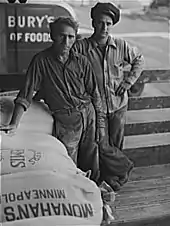

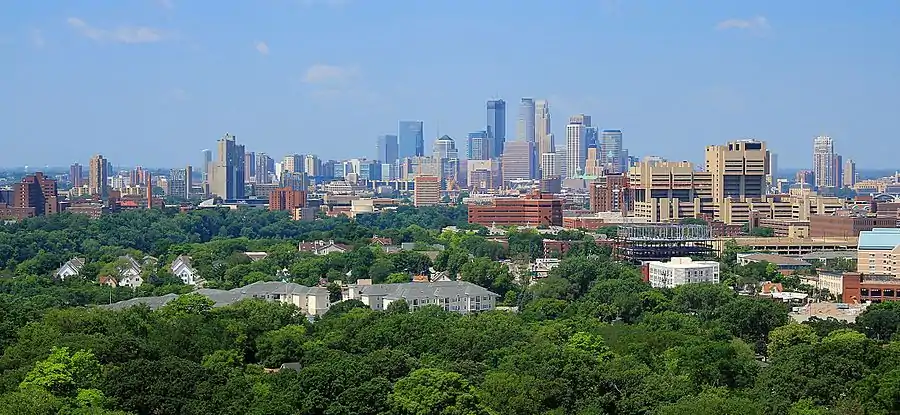
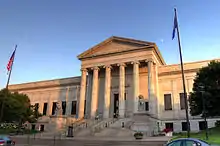


.jpg.webp)
